
How To Write an Analytical Essay

If you enjoy exploring topics deeply and thinking creatively, analytical essays could be perfect for you. They involve thorough analysis and clever writing techniques to gain fresh perspectives and deepen your understanding of the subject. In this article, our expert research paper writer will explain what an analytical essay is, how to structure it effectively and provide practical examples. This guide covers all the essentials for your writing success!
What Is an Analytical Essay
An analytical essay involves analyzing something, such as a book, movie, or idea. It relies on evidence from the text to logically support arguments, avoiding emotional appeals or personal stories. Unlike persuasive essays, which argue for a specific viewpoint, a good analytical essay explores all aspects of the topic, considering different perspectives, dissecting arguments, and evaluating evidence carefully. Ultimately, you'll need to present your own stance based on your analysis, synthesize findings, and decide whether you agree with the conclusions or have your own interpretation.
Wondering How to Impress Your Professor with Your Essay?
Let our writers craft you a winning essay, no matter the subject, field, type, or length!
How to Structure an Analytical Essay
Crafting an excellent paper starts with clear organization and structuring of arguments. An analytical essay structure follows a simple outline: introduction, body, and conclusion.
Introduction: Begin by grabbing the reader's attention and stating the topic clearly. Provide background information, state the purpose of the paper, and hint at the arguments you'll make. The opening sentence should be engaging, such as a surprising fact or a thought-provoking question. Then, present your thesis, summarizing your stance in the essay.
Body Paragraphs: Each paragraph starts with a clear topic sentence guiding the reader and presents evidence supporting the thesis. Focus on one issue per paragraph and briefly restate the main point at the end to transition smoothly to the next one. This ensures clarity and coherence in your argument.
Conclusion: Restate the thesis, summarize key points from the body paragraphs, and offer insights on the significance of the analysis. Provide your thoughts on the topic's importance and how your analysis contributes to it, leaving a lasting impression on the reader.
Meanwhile, you might also be interested in how to write a reflection paper , so check out the article for more information!
How to Write an Analytical Essay in 6 Simple Steps
Once you've got a handle on the structure, you can make writing easier by following some steps. Preparing ahead of time can make the process smoother and improve your essay's flow. Here are some helpful tips from our experts. And if you need it, you can always request our experts to write my essay for me , and we'll handle it promptly.
.webp)
Step 1: Decide on Your Stance
Before diving into writing, it's crucial to establish your stance on the topic. Let's say you're going to write an analytical essay example about the benefits and drawbacks of remote work. Before you start writing, you need to decide what your opinion or viewpoint is on this topic.
- Do you think remote work offers flexibility and improved work-life balance for employees?
- Or maybe you believe it can lead to feelings of isolation and decreased productivity?
Once you've determined your stance on remote work, it's essential to consider the evidence and arguments supporting your position. Are there statistics or studies that back up your viewpoint? For example, if you believe remote work improves productivity, you might cite research showing increased output among remote workers. On the other hand, if you think it leads to isolation, you could reference surveys or testimonials highlighting the challenges of remote collaboration. Your opinion will shape how you write your essay, so take some time to think about what you believe about remote work before you start writing.
Step 2: Write Your Thesis Statement
Once you've figured out what you think about the topic, it's time to write your thesis statement. This statement is like the main idea or argument of your essay.
If you believe that remote work offers significant benefits, your thesis statement might be: 'Remote work presents an opportunity for increased flexibility and work-life balance, benefiting employees and employers alike in today's interconnected world.'
Alternatively, if you believe that remote work has notable drawbacks, your thesis statement might be: 'While remote work offers flexibility, it can also lead to feelings of isolation and challenges in collaboration, necessitating a balanced approach to its implementation.'
Your thesis statement guides the rest of your analytical essay, so make sure it clearly expresses your viewpoint on the benefits and drawbacks of remote work.
Step 3: Write Topic Sentences
After you have your thesis statement about the benefits and drawbacks of remote work, you need to come up with topic sentences for each paragraph while writing an analytical essay. These sentences introduce the main point of each paragraph and help to structure your essay.
Let's say your first paragraph is about the benefits of remote work. Your topic sentence might be: 'Remote work offers employees increased flexibility and autonomy, enabling them to better manage their work-life balance.'
For the next paragraph discussing the drawbacks of remote work, your topic sentence could be: 'However, remote work can also lead to feelings of isolation and difficulties in communication and collaboration with colleagues.'
And for the paragraph about potential solutions to the challenges of remote work, your topic sentence might be: 'To mitigate the drawbacks of remote work, companies can implement strategies such as regular check-ins, virtual team-building activities, and flexible work arrangements.'
Each topic sentence should relate back to your thesis statement about the benefits and drawbacks of remote work and provide a clear focus for the paragraph that follows.
Step 4: Create an Outline
Now that you have your thesis statement and topic sentences, it's time to create an analytical essay outline to ensure your essay flows logically. Here's an outline prepared by our analytical essay writer based on the example of discussing the benefits and drawbacks of remote work:
Step 5: Write Your First Draft
Now that you have your outline, it's time to start writing your first draft. Begin by expanding upon each point in your outline, making sure to connect your ideas smoothly and logically. Don't worry too much about perfection at this stage; the goal is to get your ideas down on paper. You can always revise and polish your draft later.
As you write, keep referring back to your thesis statement to ensure that your arguments align with your main argument. Additionally, make sure each paragraph flows naturally into the next, maintaining coherence throughout your essay.
Once you've completed your first draft, take a break and then come back to review and revise it. Look for areas where you can strengthen your arguments, clarify your points, and improve the overall structure and flow of your essay.
Remember, writing is a process, and it's okay to go through multiple drafts before you're satisfied with the final result. Take your time and be patient with yourself as you work towards creating a well-crafted essay on the benefits and drawbacks of remote work.
Step 6: Revise and Proofread
Once you've completed your first draft, it's essential to revise and proofread your essay to ensure clarity, coherence, and correctness. Here's how to approach this step:
- Check if your ideas make sense and if they support your main point.
- Make sure your writing style stays the same and your format follows the rules.
- Double-check your facts and make sure you've covered everything important.
- Cut out any extra words and make your sentences clear and short.
- Look for mistakes in spelling and grammar.
- Ask someone to read your essay and give you feedback.
What is the Purpose of an Analytical Essay?
Analytical essays aim to analyze texts or topics, presenting a clear argument. They deepen understanding by evaluating evidence and uncovering underlying meanings. These essays promote critical thinking, challenging readers to consider different viewpoints.
They're also great for improving critical thinking skills. By breaking down complex ideas and presenting them clearly, they encourage readers to think for themselves and reach their own conclusions.
This type of essay also adds to academic discussions by offering fresh insights. By analyzing existing research and literature, they bring new perspectives or shine a light on overlooked parts of a topic. This keeps academic conversations lively and encourages more exploration in the field.
Analytical Essay Examples
Check out our essay samples to see theory in action. Crafted by our dissertation services , they show how analytical thinking applies to real situations, helping you understand concepts better.
With our tips on how to write an analytical essay, you're ready to boost your writing skills and craft essays that captivate your audience. With practice, you'll become a pro at analytical writing, ready to tackle any topic with confidence. And, if you need help to buy essay online , just drop us a line saying ' do my homework for me ' and we'll jump right in!
Do Analytical Essays Tend to Intimidate You?
Give us your assignment to uncover a deeper understanding of your chosen analytical essay topic!
How to Write an Analytical Essay?
What is an analytical essay, related articles.
.webp)
The Ultimate Guide to Analytical Essay Writing: How to Craft an A-Grade Paper?
25 January, 2021
17 minutes read
Author: Kate Smith
An analytical essay is often considered the most challenging piece of writing. However, those who have dealt with it at least once are a step closer to calling themselves masters of essay writing. This type of paper requires plenty of analytical skills to carry out an in-depth analysis of the assigned topic. Yet, the main goal of an analytical essay is not only to demonstrate your ability to learn the basics of the theme.

You also need to think critically, analyze facts, express your standpoint, and clearly show a deep understanding of key concepts. In short, your main task as an author is to prove the validity of your views by coming up with strong arguments that do not beg any questions.

The given guide provides a full analytical essay definition, as well as specifies its features and structural aspects. The following information will help you properly start your paper, choose a relevant topic, and come up with compelling conclusions.
What is an Analytical Essay?
An analytical essay is a piece of writing aimed to provide a thorough analysis of a definite phenomenon using persuasive arguments and supporting assertions. Analysis in the analytical essay writing process stands for a method of research that allows one to study specific features of an object. Analytical papers also have to do with analysis of a specific problem; that is consideration of the problem itself and identification of its key patterns. The subject matter of analysis can be a well-known or little-studied scientific phenomenon, artistic work, historical event, social problem, etc.
The content of an analytical essay will totally depend on the object that has been chosen for analysis. Thus, when shedding light on any kind of scientific work, an analytical essay can be devoted to the analysis of research credibility, its relevance, or the adequacy of conclusions. When considering a work of art, an essay writer can focus on the analysis of the author’s artistic techniques or issues raised in the book. For this reason, it is essential to accurately determine the topic and subject matter of your future analytical essay.
Steps to Take Before Writing
The preparational stage of analytical essay writing cannot be omitted. It lays the basis for the A-grade paper and should be carefully completed. If you don’t know how to start an analytical essay, read a few handy tips that will ensure a solid foundation for your paper.
Define a subject matter
You first need to clearly understand the issue you will base your essay on. Since analytical essays imply an in-depth analysis of a specific problem, you need to define its core. Try to split the analysis into several components and provide arguments taken either from a book, a research, a scientific work, or a movie (depending on the subject matter of your analysis), and support your views comprehensively.
Decide on the content of your analytical essay
If you are a student who was given an analytical essay topic, read the task several times before you are 100% sure that you clearly understand the requirements as to the analytical essay format. In case you were lucky to choose the topic of the analytical paper by yourself, make sure the theme you will be dealing with is familiar or at least seems interesting to you.
Remember that different subject matters require a different approach to their analysis. If you examine some literature work, you can prove your opinion based on the deeds of a certain or several characters. But if you have been assigned the task to elaborate on some historic events, analyze their main causes, driving forces that have affected their course, and their global consequences.
Take care of the proper start
Don’t forget to start your analytical essay with a thesis statement. It is a sentence or a couple of sentences that aim to summarize the key statements of your paper. A thesis statement should provide readers with a preliminary idea of what your essay is all about.
Find extra reasoning
Make sure your thesis is supported by compelling arguments. To find enough evidence, you should carry out a thorough analysis of the assigned topic. List the crucial points of your research and ponder over the ways they can be used to prove your final opinion.
Elaborate the outline
A sound outline elaborated at the preparation stage will help you ensure a proper analytical essay structure and make the overall writing process easier. As a rule, an analytical essay consists of an introduction, three body paragraphs, and a conclusion. Your outline plan should include the key arguments you want to discuss in each paragraph.
Analytical Essay Thesis
A thesis statement represents the central idea of your paper and must serve as strong proof of your standpoint. While elaborating your thesis statement, it is crucial to include it at the end of the first paragraph and thus set a direction for the overall paper.
Analytical Essay Outline
An outline is not a required element of analytical essays writing and should not be included in the text, but it can greatly facilitate the whole process of paper writing.
The analytical essay structure looks as follows:
Introduction
In the introduction of an analytical essay, you will need to identify your paper’s subject matter. Mention the purpose of your work and specify its scope of research. Don’t forget to include a thesis to let readers know what your work is about.
Body Section
As has already been mentioned, the body section covers three or more main paragraphs, each being supported with arguments and details. Besides, you need to provide a small conclusion to each statement to make your essay sound professional and persuasive.
At this stage, you need to summarize the points elucidated in your paper and make sure there is a smooth and logical transition from the body section to the concluding part of the text. If you don’t know how to conclude an analytical essay, try to restate the thesis statement without copying it word for word.
Analytical Essay Examples
Writing an analytical essay may seem to be a thorny way. If you are still not sure how to properly craft one, try to find some examples that will help you go in the right direction. Below, there are some great examples of analytical essays. Take a look at their structure and try to write something similar based on your views and ideas:
https://drive.google.com/file/d/1JeR4i4RIZIj448W3KVFyHP-eS3QPN7gW/view
https://stlcc.edu/docs/student-support/academic-support/college-writing-center/rhetorical-analysis-sample-essay.pdf
https://www.germanna.eduhttp://handmadewriting.com/wp-content/uploads/tutoring/handouts/Literary-Analysis-Sample-Paper.pdf
30 Analytical Essay Topics
If you were allowed to choose the theme for your paper by yourself, check on the following analytical essay topics. Each of them can bring you the highest score:
General topics
- The influence of social networks on the life of teens
- Are salaries of football players too high?
- Wearing uniforms in schools should be banned
- A person in society: the problems of loneliness and privacy
- Sociology of corporate relationships
- Does the observation of space need more investments?
- Should the voting age in the UK be decreased?
- Reasons why capital punishment should be brought back in the UK
- A world with no rules: a new human era or a road to the global collapse?
- Life without technologies: will modern people survive?
- Should scientists test drugs on animals to fight cancer?
- The problem of keeping the balance between career and family life
- The importance of listening to your body
- Problems caused by the lack of communication
- Food addiction and the problems it causes
- Problems of vaccination in the XXI century
- Does evil really rule the world?
- How does body size affect life quality?
- Pros and cons of video games
- The role of a family model in the life and career of a person
Analytical Essay Topics on Literature
- “Robinson Crusoe”: fantasy vs reality
- Observation of the artistic uniqueness in the comedy by W. Shakespeare “A Midsummer Night’s Dream”
- Observe the social problems in the novel by John Steinbeck “The Grapes of Wrath”
- Convulsions and death of the “little man” in the networks of impersonal, alienated forces in the novel “The Metamorphosis”
- Observation of the problems of a man on a plagued land in the novel “The Plague”
- Revolt of the protagonist in the novel by J. Salinger “The Catcher in the Rye”
- Observation of friendship and love in the fate of humanity in the XX century
- The triumph of immorality in the novel by F. Sagan “Hello Sadness”
- Observation of the personality of an American student in the novel by J. Salinger “The Catcher in the Rye”
- Eternal tragedies of humanity in the tragedy by W. Shakespeare “The Tragedy of Hamlet, Prince of Denmark”
How to Write a Well-Structured Analytical Essay With a Solid Argument
Writing an analytical essay with a clear structure might be challenging unless you are thoroughly prepared. We decided to help you out and create a detailed guide listing the main things to consider when creating an analytical essay outline. You need to explain your main idea in a concise way to bring your point across. As analytical writing has high requirements, it pays off to find an analytical essay example and analyze how this text was written. It will allow you to understand the analytical essay format better and learn how to provide substantive analysis on various topics. Read on to learn how to write a top-level analytical paper and submit it on time.
Main Tips for Writing an Analytical Essay
An analytical essay should provide a comprehensive analysis of a chosen topic. What makes an analysis essay different from other assignments is that it includes a personal opinion of an author. This is why analytical writing should be persuasive.
Below, we have rounded up the key tips you need to follow when producing an analytical essay outline and the main body of your text. Read on to learn more about the analytical essay format and create a text that will fully meet the requirements.
Select an Analytical Essay Topic
Before creating an analytical essay outline, make sure to pick a topic that you are interested in. It should be provocative enough to engage your readers. A widely-debated topic will help you write an analytical essay that grabs the attention of a wide audience.
Consider your goals and conduct thorough research to see if you have enough sources to support the main thesis of your analysis essay.
Come Up With a Strong Analytical Thesis Statement
When writing an analytical essay, start by formulating a thesis statement that includes the topic and the main goal of your text. It will help you create an analytical essay outline and show your readers what you will discuss in your analysis essay.
Add it to the last paragraph of your analytical essay introduction. Due to this, your analytical essay outline will look better structured. Look at any analytical essay example to see how you can introduce your subject. In most cases, one sentence will suffice to state your analysis essay’s goal. However, a complex analytical essay outline might require you to use two sentences for a thesis statement.
Write an Analytical Essay Body with a Clear Structure
Your analytical essay outline should include 3-4 paragraphs. However, a literary analysis essay usually consists of 5 paragraphs. When it comes to analytical writing, it is important to cover a different point in each section of the main body of an analysis paper.
After writing an analytical essay, check whether each paragraph contains an introduction and the main point. Besides, it should contain evidence. An expertly written analytical essay outline will help you reach out to your target audience more effectively.
Conduct Research Before Writing an Analytical Essay Outline
While this step is preparatory, it is a must for those who want to write a well-grounded analytical paper.
- First, select the best ideas for your essay
- Then, emphasize the problems with works written by other researchers
- Finally, write your analytical essay outline to demonstrate what approach you want to take
Examine the context and find examples to illustrate the scope of the issue. You may draw parallels to emphasize your point and make your topic more relatable.
Analyze the Implications of the Evidence
After listing your pieces of evidence and demonstrating how it is related to your thesis, show why it is important. You need to explore it deeply and use it to support your argument. It will make your analytical essay outline well-grounded facts.
Write an Analytical Essay Conclusion
Whether you write a literary analysis essay or other types of assignments, there is no need to add any new data at the end of your analysis paper. Instead, summarize the arguments you mentioned in your analytical essay outline. The conclusion of your analysis essay should be short and clear. Here, you need to demonstrate that you have achieved your goals.
Analytical Essay Writing Tips
If you want to get the highest grade for your analytical essay, you need to know a little bit more than just the basics of paper writing. Read these handy tips to write a perfect essay you will be proud of:
- Double-check your paper for spelling and grammar mistakes. In case your essay contains too many errors, neither an in-depth analysis nor the elaborate writing style will make it look any better. Situations when essays of great value in terms of research and a message they convey are poorly assessed because of the abundance of mistakes are not rare. Make sure you have enough time to proofread your paper before submission. Also, you may consider asking somebody to take a fresh look at your essay and check it for you.
- Reading your analytical essay out loud helps you discover all types of errors or weak phrases. This method might seem a bit uncomfortable, but it has proved to be very effective for many students. Note that silent reading of your paper isn’t even half as helpful as reading it aloud.
- Another great idea to check on the rhythm and flow of your paper is to ask someone to read it for you. While listening to the text, you could perceive it from another perspective and discover even more inconsistencies and mistakes.
- Double-check the facts you use in your analytical essay. The names of people, books, research, publications, as well as dates of historical events are too important to be misspelled. Things like these show your professionalism and the way you treat your readers.
Write an Analytical Essay with HandmadeWriting
Writing an analytical essay requires time, strong writing skills, great attention to detail, and a huge interest in the assigned topic. However, life can be unpredictable sometimes, and students might find themselves at risk of failing their creative assignments. Stress, family issues, poor health, and even unwillingness to work on a certain topic may become significant obstacles on their way to the A-grade work.
If you have similar problems, there is no need to compromise your reputation and grades. You can always refer to HandmadeWriting professionals who are ready to help you with a paper of any type and complexity. They will understand your individual style and totally devote themselv

A life lesson in Romeo and Juliet taught by death
Due to human nature, we draw conclusions only when life gives us a lesson since the experience of others is not so effective and powerful. Therefore, when analyzing and sorting out common problems we face, we may trace a parallel with well-known book characters or real historical figures. Moreover, we often compare our situations with […]

Ethical Research Paper Topics
Writing a research paper on ethics is not an easy task, especially if you do not possess excellent writing skills and do not like to contemplate controversial questions. But an ethics course is obligatory in all higher education institutions, and students have to look for a way out and be creative. When you find an […]

Art Research Paper Topics
Students obtaining degrees in fine art and art & design programs most commonly need to write a paper on art topics. However, this subject is becoming more popular in educational institutions for expanding students’ horizons. Thus, both groups of receivers of education: those who are into arts and those who only get acquainted with art […]

Choose Your Test
Sat / act prep online guides and tips, 5 steps to write a great analytical essay.
General Education

Do you need to write an analytical essay for school? What sets this kind of essay apart from other types, and what must you include when you write your own analytical essay? In this guide, we break down the process of writing an analytical essay by explaining the key factors your essay needs to have, providing you with an outline to help you structure your essay, and analyzing a complete analytical essay example so you can see what a finished essay looks like.
What Is an Analytical Essay?
Before you begin writing an analytical essay, you must know what this type of essay is and what it includes. Analytical essays analyze something, often (but not always) a piece of writing or a film.
An analytical essay is more than just a synopsis of the issue though; in this type of essay you need to go beyond surface-level analysis and look at what the key arguments/points of this issue are and why. If you’re writing an analytical essay about a piece of writing, you’ll look into how the text was written and why the author chose to write it that way. Instead of summarizing, an analytical essay typically takes a narrower focus and looks at areas such as major themes in the work, how the author constructed and supported their argument, how the essay used literary devices to enhance its messages, etc.
While you certainly want people to agree with what you’ve written, unlike with persuasive and argumentative essays, your main purpose when writing an analytical essay isn’t to try to convert readers to your side of the issue. Therefore, you won’t be using strong persuasive language like you would in those essay types. Rather, your goal is to have enough analysis and examples that the strength of your argument is clear to readers.
Besides typical essay components like an introduction and conclusion, a good analytical essay will include:
- A thesis that states your main argument
- Analysis that relates back to your thesis and supports it
- Examples to support your analysis and allow a more in-depth look at the issue
In the rest of this article, we’ll explain how to include each of these in your analytical essay.
How to Structure Your Analytical Essay
Analytical essays are structured similarly to many other essays you’ve written, with an introduction (including a thesis), several body paragraphs, and a conclusion. Below is an outline you can follow when structuring your essay, and in the next section we go into more detail on how to write an analytical essay.
Introduction
Your introduction will begin with some sort of attention-grabbing sentence to get your audience interested, then you’ll give a few sentences setting up the topic so that readers have some context, and you’ll end with your thesis statement. Your introduction will include:
- Brief background information explaining the issue/text
- Your thesis
Body Paragraphs
Your analytical essay will typically have three or four body paragraphs, each covering a different point of analysis. Begin each body paragraph with a sentence that sets up the main point you’ll be discussing. Then you’ll give some analysis on that point, backing it up with evidence to support your claim. Continue analyzing and giving evidence for your analysis until you’re out of strong points for the topic. At the end of each body paragraph, you may choose to have a transition sentence that sets up what the next paragraph will be about, but this isn’t required. Body paragraphs will include:
- Introductory sentence explaining what you’ll cover in the paragraph (sort of like a mini-thesis)
- Analysis point
- Evidence (either passages from the text or data/facts) that supports the analysis
- (Repeat analysis and evidence until you run out of examples)
You won’t be making any new points in your conclusion; at this point you’re just reiterating key points you’ve already made and wrapping things up. Begin by rephrasing your thesis and summarizing the main points you made in the essay. Someone who reads just your conclusion should be able to come away with a basic idea of what your essay was about and how it was structured. After this, you may choose to make some final concluding thoughts, potentially by connecting your essay topic to larger issues to show why it’s important. A conclusion will include:
- Paraphrase of thesis
- Summary of key points of analysis
- Final concluding thought(s)

5 Steps for Writing an Analytical Essay
Follow these five tips to break down writing an analytical essay into manageable steps. By the end, you’ll have a fully-crafted analytical essay with both in-depth analysis and enough evidence to support your argument. All of these steps use the completed analytical essay in the next section as an example.
#1: Pick a Topic
You may have already had a topic assigned to you, and if that’s the case, you can skip this step. However, if you haven’t, or if the topic you’ve been assigned is broad enough that you still need to narrow it down, then you’ll need to decide on a topic for yourself. Choosing the right topic can mean the difference between an analytical essay that’s easy to research (and gets you a good grade) and one that takes hours just to find a few decent points to analyze
Before you decide on an analytical essay topic, do a bit of research to make sure you have enough examples to support your analysis. If you choose a topic that’s too narrow, you’ll struggle to find enough to write about.
For example, say your teacher assigns you to write an analytical essay about the theme in John Steinbeck’s The Grapes of Wrath of exposing injustices against migrants. For it to be an analytical essay, you can’t just recount the injustices characters in the book faced; that’s only a summary and doesn’t include analysis. You need to choose a topic that allows you to analyze the theme. One of the best ways to explore a theme is to analyze how the author made his/her argument. One example here is that Steinbeck used literary devices in the intercalary chapters (short chapters that didn’t relate to the plot or contain the main characters of the book) to show what life was like for migrants as a whole during the Dust Bowl.
You could write about how Steinbeck used literary devices throughout the whole book, but, in the essay below, I chose to just focus on the intercalary chapters since they gave me enough examples. Having a narrower focus will nearly always result in a tighter and more convincing essay (and can make compiling examples less overwhelming).
#2: Write a Thesis Statement
Your thesis statement is the most important sentence of your essay; a reader should be able to read just your thesis and understand what the entire essay is about and what you’ll be analyzing. When you begin writing, remember that each sentence in your analytical essay should relate back to your thesis
In the analytical essay example below, the thesis is the final sentence of the first paragraph (the traditional spot for it). The thesis is: “In The Grapes of Wrath’s intercalary chapters, John Steinbeck employs a variety of literary devices and stylistic choices to better expose the injustices committed against migrants in the 1930s.” So what will this essay analyze? How Steinbeck used literary devices in the intercalary chapters to show how rough migrants could have it. Crystal clear.
#3: Do Research to Find Your Main Points
This is where you determine the bulk of your analysis--the information that makes your essay an analytical essay. My preferred method is to list every idea that I can think of, then research each of those and use the three or four strongest ones for your essay. Weaker points may be those that don’t relate back to the thesis, that you don’t have much analysis to discuss, or that you can’t find good examples for. A good rule of thumb is to have one body paragraph per main point
This essay has four main points, each of which analyzes a different literary device Steinbeck uses to better illustrate how difficult life was for migrants during the Dust Bowl. The four literary devices and their impact on the book are:
- Lack of individual names in intercalary chapters to illustrate the scope of the problem
- Parallels to the Bible to induce sympathy for the migrants
- Non-showy, often grammatically-incorrect language so the migrants are more realistic and relatable to readers
- Nature-related metaphors to affect the mood of the writing and reflect the plight of the migrants
#4: Find Excerpts or Evidence to Support Your Analysis
Now that you have your main points, you need to back them up. If you’re writing a paper about a text or film, use passages/clips from it as your main source of evidence. If you’re writing about something else, your evidence can come from a variety of sources, such as surveys, experiments, quotes from knowledgeable sources etc. Any evidence that would work for a regular research paper works here.
In this example, I quoted multiple passages from The Grapes of Wrath in each paragraph to support my argument. You should be able to back up every claim you make with evidence in order to have a strong essay.
#5: Put It All Together
Now it's time to begin writing your essay, if you haven’t already. Create an introductory paragraph that ends with the thesis, make a body paragraph for each of your main points, including both analysis and evidence to back up your claims, and wrap it all up with a conclusion that recaps your thesis and main points and potentially explains the big picture importance of the topic.

Analytical Essay Example + Analysis
So that you can see for yourself what a completed analytical essay looks like, here’s an essay I wrote back in my high school days. It’s followed by analysis of how I structured my essay, what its strengths are, and how it could be improved.
One way Steinbeck illustrates the connections all migrant people possessed and the struggles they faced is by refraining from using specific titles and names in his intercalary chapters. While The Grapes of Wrath focuses on the Joad family, the intercalary chapters show that all migrants share the same struggles and triumphs as the Joads. No individual names are used in these chapters; instead the people are referred to as part of a group. Steinbeck writes, “Frantic men pounded on the doors of the doctors; and the doctors were busy. And sad men left word at country stores for the coroner to send a car,” (555). By using generic terms, Steinbeck shows how the migrants are all linked because they have gone through the same experiences. The grievances committed against one family were committed against thousands of other families; the abuse extends far beyond what the Joads experienced. The Grapes of Wrath frequently refers to the importance of coming together; how, when people connect with others their power and influence multiplies immensely. Throughout the novel, the goal of the migrants, the key to their triumph, has been to unite. While their plans are repeatedly frustrated by the government and police, Steinbeck’s intercalary chapters provide a way for the migrants to relate to one another because they have encountered the same experiences. Hundreds of thousands of migrants fled to the promised land of California, but Steinbeck was aware that numbers alone were impersonal and lacked the passion he desired to spread. Steinbeck created the intercalary chapters to show the massive numbers of people suffering, and he created the Joad family to evoke compassion from readers. Because readers come to sympathize with the Joads, they become more sensitive to the struggles of migrants in general. However, John Steinbeck frequently made clear that the Joads were not an isolated incident; they were not unique. Their struggles and triumphs were part of something greater. Refraining from specific names in his intercalary chapters allows Steinbeck to show the vastness of the atrocities committed against migrants.
Steinbeck also creates significant parallels to the Bible in his intercalary chapters in order to enhance his writing and characters. By using simple sentences and stylized writing, Steinbeck evokes Biblical passages. The migrants despair, “No work till spring. No work,” (556). Short, direct sentences help to better convey the desperateness of the migrants’ situation. Throughout his novel, John Steinbeck makes connections to the Bible through his characters and storyline. Jim Casy’s allusions to Christ and the cycle of drought and flooding are clear biblical references. By choosing to relate The Grapes of Wrath to the Bible, Steinbeck’s characters become greater than themselves. Starving migrants become more than destitute vagrants; they are now the chosen people escaping to the promised land. When a forgotten man dies alone and unnoticed, it becomes a tragedy. Steinbeck writes, “If [the migrants] were shot at, they did not run, but splashed sullenly away; and if they were hit, they sank tiredly in the mud,” (556). Injustices committed against the migrants become greater because they are seen as children of God through Steinbeck’s choice of language. Referencing the Bible strengthens Steinbeck’s novel and purpose: to create understanding for the dispossessed. It is easy for people to feel disdain for shabby vagabonds, but connecting them to such a fundamental aspect of Christianity induces sympathy from readers who might have otherwise disregarded the migrants as so many other people did.
The simple, uneducated dialogue Steinbeck employs also helps to create a more honest and meaningful representation of the migrants, and it makes the migrants more relatable to readers. Steinbeck chooses to accurately represent the language of the migrants in order to more clearly illustrate their lives and make them seem more like real paper than just characters in a book. The migrants lament, “They ain’t gonna be no kinda work for three months,” (555). There are multiple grammatical errors in that single sentence, but it vividly conveys the despair the migrants felt better than a technically perfect sentence would. The Grapes of Wrath is intended to show the severe difficulties facing the migrants so Steinbeck employs a clear, pragmatic style of writing. Steinbeck shows the harsh, truthful realities of the migrants’ lives and he would be hypocritical if he chose to give the migrants a more refined voice and not portray them with all their shortcomings. The depiction of the migrants as imperfect through their language also makes them easier to relate to. Steinbeck’s primary audience was the middle class, the less affluent of society. Repeatedly in The Grapes of Wrath , the wealthy make it obvious that they scorn the plight of the migrants. The wealthy, not bad luck or natural disasters, were the prominent cause of the suffering of migrant families such as the Joads. Thus, Steinbeck turns to the less prosperous for support in his novel. When referring to the superior living conditions barnyard animals have, the migrants remark, “Them’s horses-we’re men,” (556). The perfect simplicity of this quote expresses the absurdness of the migrants’ situation better than any flowery expression could.
In The Grapes of Wrath , John Steinbeck uses metaphors, particularly about nature, in order to illustrate the mood and the overall plight of migrants. Throughout most of the book, the land is described as dusty, barren, and dead. Towards the end, however; floods come and the landscape begins to change. At the end of chapter twenty-nine, Steinbeck describes a hill after the floods saying, “Tiny points of grass came through the earth, and in a few days the hills were pale green with the beginning year,” (556). This description offers a stark contrast from the earlier passages which were filled with despair and destruction. Steinbeck’s tone from the beginning of the chapter changes drastically. Early in the chapter, Steinbeck had used heavy imagery in order to convey the destruction caused by the rain, “The streams and the little rivers edged up to the bank sides and worked at willows and tree roots, bent the willows deep in the current, cut out the roots of cottonwoods and brought down the trees,” (553). However, at the end of the chapter the rain has caused new life to grow in California. The new grass becomes a metaphor representing hope. When the migrants are at a loss over how they will survive the winter, the grass offers reassurance. The story of the migrants in the intercalary chapters parallels that of the Joads. At the end of the novel, the family is breaking apart and has been forced to flee their home. However, both the book and final intercalary chapter end on a hopeful note after so much suffering has occurred. The grass metaphor strengthens Steinbeck’s message because it offers a tangible example of hope. Through his language Steinbeck’s themes become apparent at the end of the novel. Steinbeck affirms that persistence, even when problems appear insurmountable, leads to success. These metaphors help to strengthen Steinbeck’s themes in The Grapes of Wrath because they provide a more memorable way to recall important messages.
John Steinbeck’s language choices help to intensify his writing in his intercalary chapters and allow him to more clearly show how difficult life for migrants could be. Refraining from using specific names and terms allows Steinbeck to show that many thousands of migrants suffered through the same wrongs. Imitating the style of the Bible strengthens Steinbeck’s characters and connects them to the Bible, perhaps the most famous book in history. When Steinbeck writes in the imperfect dialogue of the migrants, he creates a more accurate portrayal and makes the migrants easier to relate to for a less affluent audience. Metaphors, particularly relating to nature, strengthen the themes in The Grapes of Wrath by enhancing the mood Steinbeck wants readers to feel at different points in the book. Overall, the intercalary chapters that Steinbeck includes improve his novel by making it more memorable and reinforcing the themes Steinbeck embraces throughout the novel. Exemplary stylistic devices further persuade readers of John Steinbeck’s personal beliefs. Steinbeck wrote The Grapes of Wrath to bring to light cruelties against migrants, and by using literary devices effectively, he continuously reminds readers of his purpose. Steinbeck’s impressive language choices in his intercalary chapters advance the entire novel and help to create a classic work of literature that people still are able to relate to today.
This essay sticks pretty closely to the standard analytical essay outline. It starts with an introduction, where I chose to use a quote to start off the essay. (This became my favorite way to start essays in high school because, if I wasn’t sure what to say, I could outsource the work and find a quote that related to what I’d be writing about.) The quote in this essay doesn’t relate to the themes I’m discussing quite as much as it could, but it’s still a slightly different way to start an essay and can intrigue readers. I then give a bit of background on The Grapes of Wrath and its themes before ending the intro paragraph with my thesis: that Steinbeck used literary devices in intercalary chapters to show how rough migrants had it.
Each of my four body paragraphs is formatted in roughly the same way: an intro sentence that explains what I’ll be discussing, analysis of that main point, and at least two quotes from the book as evidence.
My conclusion restates my thesis, summarizes each of four points I discussed in my body paragraphs, and ends the essay by briefly discussing how Steinbeck’s writing helped introduce a world of readers to the injustices migrants experienced during the dust bowl.
What does this analytical essay example do well? For starters, it contains everything that a strong analytical essay should, and it makes that easy to find. The thesis clearly lays out what the essay will be about, the first sentence of each of the body paragraph introduces the topic it’ll cover, and the conclusion neatly recaps all the main points. Within each of the body paragraphs, there’s analysis along with multiple excerpts from the book in order to add legitimacy to my points.
Additionally, the essay does a good job of taking an in-depth look at the issue introduced in the thesis. Four ways Steinbeck used literary devices are discussed, and for each of the examples are given and analysis is provided so readers can understand why Steinbeck included those devices and how they helped shaped how readers viewed migrants and their plight.
Where could this essay be improved? I believe the weakest body paragraph is the third one, the one that discusses how Steinbeck used plain, grammatically incorrect language to both accurately depict the migrants and make them more relatable to readers. The paragraph tries to touch on both of those reasons and ends up being somewhat unfocused as a result. It would have been better for it to focus on just one of those reasons (likely how it made the migrants more relatable) in order to be clearer and more effective. It’s a good example of how adding more ideas to an essay often doesn’t make it better if they don’t work with the rest of what you’re writing. This essay also could explain the excerpts that are included more and how they relate to the points being made. Sometimes they’re just dropped in the essay with the expectation that the readers will make the connection between the example and the analysis. This is perhaps especially true in the second body paragraph, the one that discusses similarities to Biblical passages. Additional analysis of the quotes would have strengthened it.

Summary: How to Write an Analytical Essay
What is an analytical essay? A critical analytical essay analyzes a topic, often a text or film. The analysis paper uses evidence to support the argument, such as excerpts from the piece of writing. All analytical papers include a thesis, analysis of the topic, and evidence to support that analysis.
When developing an analytical essay outline and writing your essay, follow these five steps:
Reading analytical essay examples can also give you a better sense of how to structure your essay and what to include in it.
What's Next?
Learning about different writing styles in school? There are four main writing styles, and it's important to understand each of them. Learn about them in our guide to writing styles , complete with examples.
Writing a research paper for school but not sure what to write about? Our guide to research paper topics has over 100 topics in ten categories so you can be sure to find the perfect topic for you.
Literary devices can both be used to enhance your writing and communication. Check out this list of 31 literary devices to learn more !

Christine graduated from Michigan State University with degrees in Environmental Biology and Geography and received her Master's from Duke University. In high school she scored in the 99th percentile on the SAT and was named a National Merit Finalist. She has taught English and biology in several countries.
Ask a Question Below
Have any questions about this article or other topics? Ask below and we'll reply!
Improve With Our Famous Guides
- For All Students
The 5 Strategies You Must Be Using to Improve 160+ SAT Points
How to Get a Perfect 1600, by a Perfect Scorer
Series: How to Get 800 on Each SAT Section:
Score 800 on SAT Math
Score 800 on SAT Reading
Score 800 on SAT Writing
Series: How to Get to 600 on Each SAT Section:
Score 600 on SAT Math
Score 600 on SAT Reading
Score 600 on SAT Writing
Free Complete Official SAT Practice Tests
What SAT Target Score Should You Be Aiming For?
15 Strategies to Improve Your SAT Essay
The 5 Strategies You Must Be Using to Improve 4+ ACT Points
How to Get a Perfect 36 ACT, by a Perfect Scorer
Series: How to Get 36 on Each ACT Section:
36 on ACT English
36 on ACT Math
36 on ACT Reading
36 on ACT Science
Series: How to Get to 24 on Each ACT Section:
24 on ACT English
24 on ACT Math
24 on ACT Reading
24 on ACT Science
What ACT target score should you be aiming for?
ACT Vocabulary You Must Know
ACT Writing: 15 Tips to Raise Your Essay Score
How to Get Into Harvard and the Ivy League
How to Get a Perfect 4.0 GPA
How to Write an Amazing College Essay
What Exactly Are Colleges Looking For?
Is the ACT easier than the SAT? A Comprehensive Guide
Should you retake your SAT or ACT?
When should you take the SAT or ACT?
Stay Informed
Get the latest articles and test prep tips!
Looking for Graduate School Test Prep?
Check out our top-rated graduate blogs here:
GRE Online Prep Blog
GMAT Online Prep Blog
TOEFL Online Prep Blog
Holly R. "I am absolutely overjoyed and cannot thank you enough for helping me!”
How to Write an Analytical Essay
There are many types of academic papers, and each has to be written according to very specific rules. To succeed in academic writing and get high marks for writing assignments, a student should be aware of these rules and be able to follow them strictly.
An analytical essay is one of the most common essay types; every student gets to write it more than once throughout his or her school and college years. It is also one of the most complex types of essays, as it requires strong analytical and research skills and a good knowledge of analytical essay structure. In the following article, you’ll find everything you need to know about writing an analytical essay that will impress any demanding reader.
What Is an Analytical Essay?
In order to write an impressive paper, one should know the analytical essay definition and how this essay type differs from the rest. An analytical essay is a form of academic writing that focuses on details and methods rather than on the overall contents of the subject. Figuratively, it deals with the elements of the puzzle which is a complete work of art to show how the picture is made.
Considering the latter, keep in mind that analysis is an essential part of an analytical essay. A simple summary of the plot or description of an event will not make a good essay of this type. Trying to insist on your personal point of view or focusing on your own impressions from the subject will also get you to fail the assignment. An essay should be based on facts and evidence that you have proof of.
Now that we have the definition, we can move on to the next question.
Struggling with your Analytical Essay Homework?
Get your assignments done by real pros. Save your precious time and boost your marks with ease.
What Is the Analysis In Writing?
Analysis in general means dividing something into smaller elements in order to examine them (usually by asking critical questions such as “how” and “why”) and draw your own conclusions based on the results of such examination.
In your academic analytical essays, you will most probably be focusing on literary analysis. That will require you to look at how the author uses various techniques to produce certain effects, as well as how the issues are addressed. Sometimes such analysis will also require evaluating a literary work from the point of logic and proper handling of the issues of controversy.
What Is an Analytical Argument?
An analytical argument is basically the body of your essay. It is built upon a thesis statement (which we will discuss later in this article) and should focus on discussing one idea with supporting evidence.
It is important to distinguish between an argument and an opinion. An argument is always backed up by sufficient evidence. Whereas an opinion is a personal point of view that is based upon an individual experience or is downright intuitive.
Let’s see how it works.
For example, “Employees who are working from home are less productive than those who work at the office. I know that from my own family’s example – me and my husband always get interrupted and can never concentrate,” this is an opinion because it is based on individual experience.
On the contrary, “A 2019 study by Airtasker conducted among 1004 full-time employees from different parts of the U.S. found that working from home increases productivity and leads to healthier lifestyles, so remote work can be a better alternative for both companies and workers,” is an argument, as it draws conclusions based on evidence.
Having explained all these terms, we can finally discuss an analytical essay outline and structure.
Analytical Essay Outline and Structure
An analytical paper is a complex work that involves extensive research, using many sources for citations and reference, and putting together a lot of facts and thoughts on the subject. So, thorough knowledge of an analytical essay structure is essential, as is creating an outline.
An outline is a good way to encompass all the preparatory work that you do for your essay. It starts by taking down notes about possible topic ideas, arguments, and any useful resources on the subject of your paper. When you do any research, don’t forget to archive the sources and highlight the citations you might need to use in your work so that you could access them easily during your writing process. Having all this information will help you write a strong thesis, formulate persuasive arguments, and fill in the gaps in your outline step-by-step.
You can organize your outline any way you like, but the easiest and most efficient way to do it is to create a simple bulleted list. This is how it may look like.
Introduction:
- Hook statement;
- A short summary of background information;
- Thesis statement. It usually has a complex form of a number of correlating factors and should be controversial.
Body paragraphs (there are 3 of them usually) :
- Topic sentence. This is where you introduce your main point;
- Analysis. Here, you should analyze the provided evidence and determine its meaning;
- Evidence. Every paragraph should have evidential support in the form of a source or an actual quote;
- Concluding sentence. Here, you can restate and emphasize the main point.
Conclusion:
- Restatement of your thesis statement;
- Short summary of the essay’s key points;
- Proof of why the text is important.
Now that you know how to work with an outline, let’s start filling in the gaps.
Did you like our inspiring Analytical Essay Guide?
If you need help with request " write a essay for me " tap into our pool of professional writers and get expert essay writing services!
How to Start an Analytical Essay: Introduction Paragraph
An analytical essay introduction is crucial to catching your reader’s attention. Therefore, it should be relevant and concise, and provoke interest for how you’re going to develop your topic. There are three main components that an analytical essay introduction should contain:
- Thesis statement;
- A short explanation of how you’re going to prove your thesis in the following paragraphs.
A hook is immensely important for the overall impression that your essay will produce on the reader. So, it must contain something interesting, engaging, or surprising. It should instantly grab your audience’s attention and make them wonder what you have to say next. You only have one chance to win your readers at this point, so put a lot of effort into formulating a good hook. Start with finding out who your readers are, and then choose from the most effective methods of attracting their attention. You can do it with a quote, statistic figures, a rhetorical question, or a provocative statement.
Then, move on straight to your thesis statement. In this essential part of your essay, you should explain to your readers what your paper’s subject is and why it matters. You might give your own opinion about the topic, and state why it is important to read your analytical work. Read on to learn how to write a strong thesis statement – we will discuss it in the next paragraph.
How to Create a Strong Analytical Thesis Statement?
But what is a thesis statement for an analytical essay, exactly? Before we move on, let’s define the term. So, a thesis statement is basically your answer to the question posed in the topic. A thesis is usually placed at the end of the introductory paragraph and consists of one to three sentences that encompass the gist of your paper, concentrating your viewpoint on the subject and giving the reader an idea of how you’re going to develop the topic.
The claim you make in your thesis statement should be debatable so that you could have something to work with in the next sections of your essay. A strong thesis statement helps to get a clear idea of a paper from the start and serves to organize and develop the arguments in the body paragraphs.
A good thesis includes the following:
- The main idea;
- Key points of your topic;
- Your position towards the subject of the discussion;
- Conclusion.
In order to create a powerful thesis statement, follow this step-by-step guideline:
- Brainstorm an interesting topic.
- Make the topic more specific.
- Formulate the question for further research.
- Extract the main idea and make a statement.
- Decide on your position on the topic.
- Mention an opposing position.
- Support your point of view using arguments, evidence, and reasoning.
- Draw a conclusion.
There are also some things you should avoid when writing a thesis statement:
- Using common knowledge, bare facts, or quotes (all these make a poor thesis).
- Be careful not to choose topics that are too broad, and avoid language that’s vague or ambiguous.
- Exclude all information that is irrelevant to the topic and phrases like “I think”, “I believe”, etc.
To get a better understanding of what a strong thesis statement should and should not be like, compare the examples below.
- According to various studies, more than a half of first-year college students experience strong anxiety, which puts their health at a great risk. In order to protect it, psychologists should work with every freshman on campus. (Strong).
- Academic anxiety is a big problem for all students. (Weak).
Body Paragraphs of an Analytical Paper
A body paragraph is where you make an argument and bring evidence to support your claims. An analytical essay format usually implies having three of four body paragraphs. Each of them should start with a sentence that defines the main point of discussion for the paragraph – sort of a mini-thesis. Then, you should analyze this point, looking at it from different angles and bringing sufficient evidence to support your assertions. The more evidence you provide, the more persuasive your arguments will be. After you’ve run out of strong points for the arguments, move to the next paragraph. You can also add a transition sentence to make you text smoother; some professors require it, and some don’t.
So, each body paragraph should include:
- An introductory sentence;
- Evidence (actual quotes from the text, statistic figures, facts from trusted sources);
- Transition sentence to the next paragraph (mandatory).
If you still wonder about how to write a good analysis, look at the following sample body paragraph to see how it should work in an actual paper.
For example, our topic is the perception of happiness in Aldous Huxley’s “Brave New World”. The first body paragraph might be as follows:
“The world in Aldous Huxley’s “Brave New World” is a place where hardly anyone thinks about what happiness really is. Safety and stability are what matters for them the most, not happiness. But the majority of the society depicted by Huxley really considers themselves happy: they have everything they need to satisfy their basic needs, and these are all the needs they seem to have. People in the brave new world don’t have to struggle for anything, they have everything. So, in an episode where Bernard asks Lenina if she wants to be happy in her own way, she seems to not understand what he’s talking about. And what was he?.”
In the second paragraph, we can discuss Bernard’s own perception of freedom, and in the third – move on to John the Savage, who is the impersonator of freedom in the novel.
After you’ve dealt with several body paragraphs in this manner, proceed with the conclusion.
How to Conclude Your Analytical Essay?
An analytical essay conclusion is where you rephrase and emphasize your thesis statement, summarize the key points of your analysis and give some concluding afterthoughts. There’s no need to present any new ideas in the final paragraph, but it’s important to give the reader a clear idea of what your essay was about. When rephrasing anything you said earlier in your essay, be careful to keep the same meaning and avoid any ambiguity.
Here is what your essay conclusion should consist of:
- Restatement of your thesis statement in other words;
- Summary of the main points of the body paragraphs;
- Concluding afterthoughts.
That’s basically all you need to know about how to write an analytical essay. Now you can go an extra mile – examine our sample topics.
Analytical Essay Topics to Inspire
Below you’ll find an analytical essay topics list on literature, art, society, and nature. Use them for inspiration to create powerful topics of your own.
Literature:
- What are Achilles' biggest flaws? Explain the modern use of the phrase “Achilles’ heel” using the Greek hero’s motivations, character, and deeds.
- Irony in Shakespeare’s “Twelfth Night”: where does it occur? Provide examples of verbal and situational irony and explain where exactly the irony in them is and why.
- Which of the characters in Fitzgerald’s “The Great Gatsby” relates the most to “the lost generation” and why?
- What is so frightening about Aldous Huxley’s fantasy of the “Brave New World” and why has it become one of the most famous dystopias ever?
- John Updike’s Harry “Rabbit” Angstrom as an “average American man”. What makes the character so believable?
- Impressionism in art. What makes it so special?
- Modern art: is it art at all, after all? Analyze several works of modern art to explain what features they have that enable them to be considered art.
- When and how did photography become art?
- The therapeutic effect of art: does it really exist?
- Multicultural families. Is it possible to maintain an ideal cultural balance within such families?
- Feminism: do we still need it and why?
- The transformation of gender roles throughout the XX century. Was it ever avoidable?
- The Internet and its effect on the educational system. Advantages and disadvantages of its use in a study process.
- Climate change as a major threat to the stability of ecosystems worldwide.
- Can we do anything now to prevent rising numbers of natural disasters in the future?
- Is testing and experimenting on animals a necessary evil?
- Why is it essential to protect the Arctic?
- Biodiversity on Earth. Why is it so important?
When it comes to writing a good analytical essay, it's important to have a clear understanding of the analytical essay definition and structure. This type of essay requires in-depth research, critical thinking, and the ability to draw conclusions based on evidence.
To write a successful analytical essay, it's recommended to create a bulleted outline before starting to write. This can help organize your thoughts and ensure that you include all the key elements such as a hook, thesis statement, and analysis. Additionally, seeking help from online resources such as Studyfy college homework help, proofreading, tutoring, and essay editing services can also be beneficial in producing a high-quality essay.
If you are struggling to come up with a topic, putting in the effort to develop your own can greatly enhance your writing experience. However, if you need someone to write an essay for you, there are various services available such as dissertation writing services , research paper service , and admission essay writer s who can assist in creating a well-written essay.
In conclusion, writing an analytical essay can be a challenging task, but with the right resources and understanding of the essay's structure, you can produce a high-quality paper. Remember to utilize online resources such as Studyfy and take the time to develop a strong topic. Good luck in your writing endeavors!
Featured Posts
How to write a scholarship essay.

How to Write a Movie Review

How to Write an Argumentative Essay

How to Write a Cause and Effect Essay
.jpg)
How to Write an Expository Essay

How to Write a Reflective Essay

Essay Papers Writing Online
Tips and techniques for writing effective and powerful analytical essays.

Are you struggling to craft an effective analytical essay? Do you find yourself getting lost in a sea of information or unsure of how to present your analysis in a clear and concise manner? Look no further – this step-by-step guide will provide you with valuable tips and strategies to elevate your analytical essay writing skills to the next level.
Writing an analytical essay involves carefully examining a subject or topic and providing a thorough analysis and interpretation of the information gathered. It requires critical thinking, attention to detail, and the ability to express ideas and arguments coherently. In this guide, we will explore various techniques and approaches to help you develop and refine your analytical writing skills, allowing you to tackle any analytical essay with confidence and precision.
One crucial aspect of writing an analytical essay is conducting thorough research. To ensure your essay is well-informed and robust, it’s important to delve into reputable sources, such as academic journals, books, and reliable websites. By gathering a wide range of sources related to your topic, you will acquire a solid understanding of the subject matter, which will enable you to provide a comprehensive analysis in your essay.
Another essential element of analytical essay writing is the development of a strong thesis statement. Your thesis should present a clear and concise argument or claim that you will support throughout your essay. It should be specific, debatable, and relevant to the topic at hand. By crafting a well-defined thesis statement, you provide the backbone for your entire essay, guiding your analysis and helping you maintain a focused approach.
Furthermore, an effective analytical essay requires careful organization and structure. Divide your essay into logical paragraphs, each addressing a specific point or aspect of your analysis. Use topic sentences to introduce each paragraph, guiding your reader and providing a clear roadmap of your essay’s progression. Additionally, utilize transitional phrases and words to create smooth transitions between paragraphs, ensuring a cohesive and coherent flow.
Finding a Strong Topic for Your Essay

Choosing the right topic is a crucial first step in writing an analytical essay. The topic sets the tone for the entire essay and determines its scope and focus. It is important to select a topic that is engaging, relevant, and allows for in-depth analysis. This section will provide you with helpful strategies for finding a strong topic that will captivate your readers.
Gathering and Evaluating Reliable Sources

One of the key aspects of writing an analytical essay is gathering and evaluating reliable sources. The quality of your sources can greatly impact the strength and credibility of your arguments. In this section, we will explore the importance of finding trustworthy sources and discuss strategies for evaluating their reliability.
When conducting research for your essay, it is crucial to seek out sources that are authoritative and trustworthy. Reliable sources are those that have been written by experts in the field or have been published in reputable academic journals. These sources are often backed by extensive research and provide accurate and unbiased information.
When evaluating the reliability of a source, there are several factors to consider. Firstly, check the author’s credentials and expertise in the subject matter. Look for individuals who have relevant qualifications or experience in the field. This will help establish their credibility and ensure that they are knowledgeable on the topic.
In addition to the author’s credentials, consider the publication or website where the source is found. Reputable academic journals, books from respected publishers, and reputable websites such as government or educational institutions are generally more reliable sources of information. Be cautious of sources from unknown or biased sources, as they may not provide accurate or unbiased information.
Furthermore, it is important to analyze the content of the source itself. Look for evidence-based arguments, logical reasoning, and a balanced presentation of different perspectives. A reliable source should provide well-supported claims and back them up with relevant evidence and examples.
Finally, consider the date of publication. While older sources can still provide valuable insights, it is important to have up-to-date information, especially in fields that are rapidly evolving or undergoing significant changes. Check for recent studies and publications to ensure that your information is current.
In conclusion, gathering and evaluating reliable sources is a critical step in writing an analytical essay. By seeking out trustworthy sources and analyzing their credibility, you can strengthen your arguments and provide a solid foundation for your essay. Keep in mind the importance of author expertise, publication credibility, content analysis, and the recency of the information. Through careful evaluation, you can ensure that your essay is well-informed and persuasive.
Creating an Outline for Your Essay
One of the most important steps in the essay writing process is creating an outline. An outline serves as a roadmap for your essay, helping you to organize your thoughts and ideas in a logical and coherent manner.
When creating an outline for your essay, it’s important to start by identifying the main points or arguments that you want to make. These main points will serve as the foundation of your essay and should be presented in a clear and concise manner. You can think of these main points as the “backbone” of your essay.
Once you have identified the main points, you can then begin to develop subpoints that support and expand upon each main point. These subpoints should provide specific examples, evidence, or analysis to strengthen your main arguments. In essence, they help to fill in the details and provide a deeper understanding of your main points.
Organizing your main points and subpoints can be done in various ways. One common method is to use a hierarchical structure, such as an outline with Roman numerals, capital letters, and Arabic numerals. Another method is to use bullet points or a numbered list. You can choose the method that works best for you, based on the complexity of your essay and the level of detail you want to include in your outline.
As you create your outline, it’s important to keep in mind the overall structure of your essay. Your introduction should provide a brief overview of the topic and present your thesis statement. The body paragraphs should present and develop your main points and subpoints, providing evidence and analysis to support your arguments. Finally, your conclusion should summarize your main points and restate your thesis in a concise and compelling manner.
Remember that your outline is a flexible tool that can be revised and adjusted as you work on your essay. It’s not set in stone and can be modified as needed to better reflect your evolving ideas and arguments. Don’t be afraid to make changes and reorganize your outline as you go along.
In conclusion, creating an outline for your essay is an essential step in the writing process. It helps you to organize your thoughts, develop your arguments, and maintain a logical flow throughout your essay. By investing time and effort into creating a strong outline, you’ll set yourself up for success and make the writing process much smoother.
Developing a Clear and Coherent Argument
When it comes to writing analytical essays, one of the most important aspects is developing a clear and coherent argument. It is essential to have a well-structured and logical argument in order to effectively convey your ideas and convince your readers.
First and foremost, it is crucial to have a clear understanding of the topic you are writing about. Take the time to thoroughly research and gather relevant information, as this will provide you with the necessary knowledge to build a strong argument. Additionally, make sure to identify any key terms or concepts that are essential to your argument, as this will help you stay focused and ensure coherence throughout your essay.
Once you have a solid foundation of knowledge, it is important to organize your argument in a logical manner. Start by outlining the main points or claims you want to make, and then provide supporting evidence or examples for each of these points. Be sure to clearly state your thesis statement, which should summarize the main argument you are making in your essay.
In order to maintain coherence in your argument, it is important to use logical transitions between your ideas. This can be done through the use of transitional words and phrases, such as “however,” “in addition,” or “on the other hand.” These transitions will help guide your reader through your argument and ensure that your ideas flow smoothly from one point to the next.
Lastly, it is crucial to anticipate and address counterarguments in your essay. By acknowledging opposing viewpoints and effectively refuting them, you can further strengthen your overall argument. This demonstrates that you have considered multiple perspectives and have arrived at your own well-supported conclusion.
In conclusion, developing a clear and coherent argument is essential when writing analytical essays. By thoroughly researching your topic, organizing your ideas in a logical manner, using transitions effectively, and addressing counterarguments, you can effectively convey your ideas and make a convincing argument to your readers.
Strengthening Your Essay with Relevant Evidence
In order to create a compelling and persuasive analytical essay, it is essential to back up your arguments with relevant evidence. This evidence serves to support your claims and gives your essay credibility and authority.
When selecting evidence for your essay, it is important to choose examples and facts that are directly related to your topic. This will help to establish a strong connection between your argument and the evidence you present. Additionally, using relevant evidence allows you to make a more convincing case and gives your readers confidence in the validity of your assertions.
Relevant evidence can come in various forms, such as statistics, research studies, expert opinions, and real-life examples. By incorporating a mix of different types of evidence, you can strengthen the overall impact of your essay and appeal to a wider range of readers.
To ensure that the evidence you include in your essay is relevant, it is necessary to thoroughly research your topic and gather information from reliable sources. This will help you to find the most up-to-date and accurate evidence to support your arguments.
In addition to choosing relevant evidence, it is also crucial to properly integrate it into your essay. Make sure to clearly introduce each piece of evidence and explain how it supports your main points. Use strong and persuasive language to highlight the significance of the evidence and its connection to your argument.
Remember that the purpose of using relevant evidence is not only to support your argument but also to engage your readers and help them understand your perspective. By presenting well-chosen and compelling evidence, you can make your essay more persuasive and leave a lasting impression on your audience.
Related Post
How to master the art of writing expository essays and captivate your audience, step-by-step guide to crafting a powerful literary analysis essay, convenient and reliable source to purchase college essays online, tips and techniques for crafting compelling narrative essays.
How to Write an Analysis Essay: The Ultimate Study Guide

Have an analytical essay to write? We get it. We’ve been there. Fortunately, we are here for you, with some insights into writing a successful analytical paper. Keep reading this article.
Analytical Essay Definition
How to write an analytical essay: step by step, analysis essay outline, analytical essay topic.
An analytical essay is a writing assignment. Your goal here is to introduce and discuss a claim as well as to deliver a detailed review of a given topic.
You can write analysis essays on topics from different fields. These include such topics as politics, economics, art, philosophy, music, literature, etc. Analytical assignments are a substantial part of any academic work. That is why university and college students often have to compose such papers. An outstanding analytical essay intends to explain and contextualize any topic—both the author and the reader benefit from it. In order to get a clearer picture of what this type of work should look like, check out some examples in our free essays collection.

Types of Analytical Essay
There are different types of analytical essays. It is important to find out what kind of essay you will write to use the correct structure.
📌 Cause and effect analytical essay. Also known as reason and result essay, this type of work discusses the purpose of something, which then enables us to analyze it while studying its effect on other things. 📌 Comparison and contrast analysis. This essay type examines two subjects to highlight their subtle similarities or differences through contrasting, comparison, or both processes at once. 📌 Classification. This type provides classification of things with common similarities into groups or categories to better learn their nature and carry out the analysis. 📌 Process essay. Such works talk about the way of doing something in order to give some sort of guidance or directions to readers. 📌 Definition. These essays comprise research to define an idea, concept, or term and provide evidence to support it. They also contain explanation through examples.
We use all these types of analytical essays while writing different kinds of analyses. The most common variants of analysis are literary analysis, painting analysis, and analysis of speech.
Find their detailed descriptions down below!
What is a Literary Analysis
While writing a literary analysis essay, you don’t always have to study a work of literature in its entirety. Sometimes you need to describe only a particular character or one aspect of the work. When studying various literary work elements, you are likely to understand the whole piece better. This process makes literary analysis one of the most exciting types of papers.
There are two main ways of composing the work – from the style perspective and from the literature piece elements perspective.
If you want to concentrate on the style , you can consider following criteria:
- Structure and organization
- Point of view
- Word choice
- Figurative language
In case of choosing to look into the elements of the work, you need to describe these aspects:
It is also possible to analyze all these elements considering different analytical essays: cause and effect, comparison and contrast, classification, process, and definition papers.
It would be a mistake to think that an analysis of literary work is just a summary of a piece of writing. On the contrary, it is rather a debate about the work that conveys a writer’s interpretation of the work.
How to Write Painting Analysis
Analyzing a painting is never easy. If you aren’t sure where to start, remember that you don’t need to be a painter or an expert in the field. Start your writing by answering some of these questions:
🤔 When was the painting made? 🤔 How big/small is it? 🤔 What kind of painting is it? It could be a portrait, a landscape, or still life. 🤔 How does the artist use colors and shapes? 🤔 What is your idea of the mood of the picture? 🤔 Is there a story behind the image? 🤔 Do you know who the artist is? 🤔 Did the artist use any symbols in the painting? 🤔 How would you describe the brushwork? Is the paint thick or thin?
Some more tips on how to analyze a work of art :
- “Description of a painting” does not mean “analysis of a painting,” so do not dive into too much detail. Going beyond stating the obvious, a student can demonstrate a more profound understanding of the piece of art.
- Try to avoid such judgmental expressions as “I like this” or “I don’t like this.” Remember to support your opinion with evidence or justification.
- Talk about several visual elements. Make sure you discuss different visual aspects of the artwork. Do not limit your analysis to talking only about colors or patterns. Try to show the painting from different perspectives.
Speech Analysis: Overview
While writing a speech analysis, you need to answer two questions. The first question you need to discuss here is WHAT the speaker says. Analyze their speech according to the standard procedure of text analysis, conversation analysis, and dialogue analysis.
The second important question is HOW the speaker expresses the ideas. Sometimes you need to analyze it to read between the lines and get the speaker’s view better. Important messages in speeches are often sent through appearance and behavior.
When analyzing a speech, try to consider the following questions :
🔎 Who is giving a speech? 🔎 What does the speaker look like? 🔎 How are they dressed? 🔎 What is the speaker’s behavior? 🔎 Does the speaker use gestures? 🔎 What is their voice like?
Some more tips on how to analyze a speech:
- A good piece of advice is to analyze the speaker and the audience they are talking to. You can describe their background and education, the atmosphere of the meeting, the general mood of the audience.
- It is also possible to talk about the meeting itself. Maybe it is a conference or a TV show, a workshop or a big plenary. All these details are crucial because they influence the speaker directly.
Writing an analytical essay can be tricky. You need to consider many aspects if you want your work to sound competent. We’ve prepared a list of 5 key steps that will help you create the best analytical essay possible.

5 Key Steps to a Perfect Analytical Essay
1. pick a good topic.
Before talking about any topic, it is helpful to study it from the ground up. When you become a real expert on the subject, you realize that analysis is relatively simple.
Check websites of trustworthy institutions to see if they have works on similar issues, or just google published papers on related topics. They can help you structure your work better.
They can also give you inspiration about the ideas you might discuss in your work.
2. Produce an analytical thesis statement
A thesis statement is the foundation of your work. It can be expressed in one sentence and supported by the most important arguments.
A working thesis statement gives the readers a general idea of the structure of your paper. It also provides them with the central point of your work and the main arguments supporting the idea. Aside from that, it declares a position about the subject that needs discussing and proving.
Here is an example of a good thesis statement:
“Worldwide nature preserving measures should concentrate on saving endangered species. It would allow many rare kinds of animals to live and breed in a safe environment.”
3. Do your research
Before writing an essay, it is vital to study the topic thoroughly. Do not skip this step, as it is essential to demonstrate that you have learned the topic and are ready to present your results, supported by arguments. So, get ready! Read relevant studies, do experiments, collect statistics – everything counts!
4. Set a realistic goal
When choosing a goal for your research, stay realistic. Try to make your goal as precise as possible. In this case, it will be easy for you to achieve your aim and to demonstrate your results at their best. It is also easier to find arguments for and against your thesis statement if your goal is precise and narrow.
5. Create an analysis essay outline
Any written assignment needs thorough planning, and analytical essays need it too. Before you write, make a well-structured outline of your work, including every paragraph’s essential points.
An analysis essay consists of an introduction, several main body paragraphs, and a conclusion. Let’s investigate this part in more detail.
There are many ways to structure an analytical assignment. Which format is best depending on the type of essay and the main goals of the writing task? We have prepared three different kinds of outlines for you.
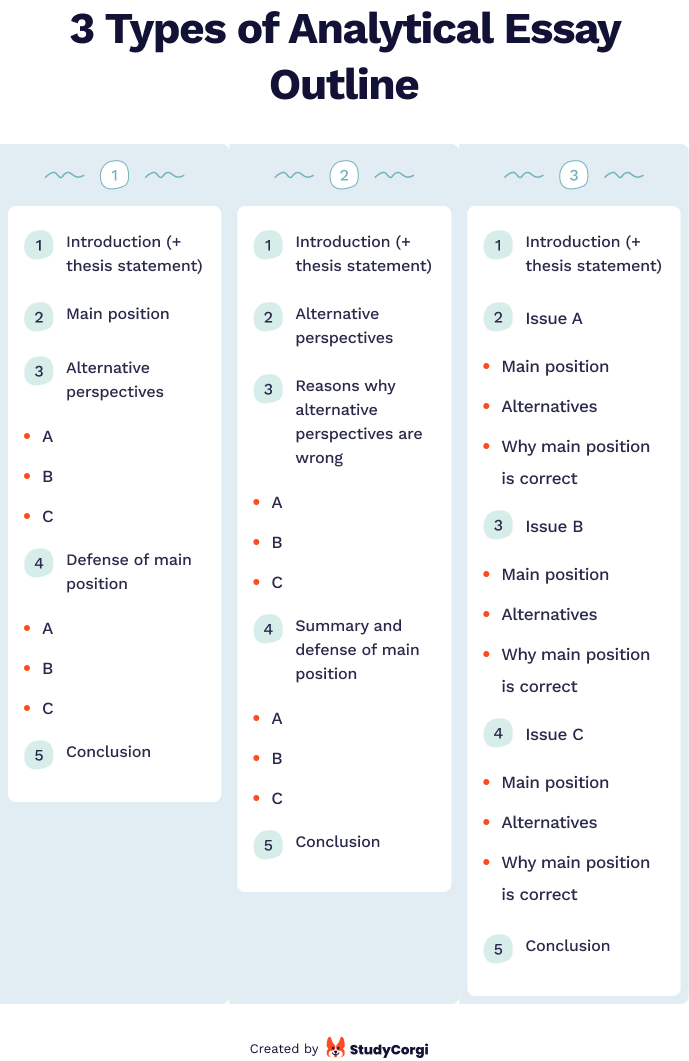
The first type of structure is perfect when you need to state the central position in the text and defend it. Concentrate on the position you take, but don’t forget to mention alternative perspectives as well. In this type of work, you do not need to explain why the alternative ways are wrong. Show the readers that they exist.
The second type is good for when you not only want to defend your position. You also aim to explain why the other perspectives are wrong. In this case, you need to think carefully about arguments for your position. You will also need arguments against the different opinions.
And the third type is a perfect fit if you aim to demonstrate a wide range of several issues.For each of them, you have the central position and defending arguments. This type of essay tends to be the longest, as it covers several issues. It also includes alternative positions on all the problems. The thing is – there is no need to prove the alternative ideas wrong. You should only defend your main statement.
Analytical Essay Introduction: Examples
The purpose of the introduction of your essay is to make the readers focus. To keep the attention, you need to include a hook in the introduction . The hook can look like a rhetorical or provocative question, a quotation, or a bold statement.
A good intro also mentions the issue you will talk about. Besides, it states the position you are taking and background information on the topic. It is usually situated at the end of the introductory paragraph.
Some examples of good introductions:
✅ “The symbolism in JD Salinger’s Franny and Zooey” keeps the feeling of melancholia and uncertainty throughout the entire novel.” ✅ “Although there are many reasons for the 2nd World War, it is nationalism that formed hatred and provoked the War’s start.” ✅ “All animals are equal, but some animals are more equal.” Animal Farm is full of ironic and provocative phrases, which invite the reader to continue exploring the story. ✅ In Animal Farm, the author uses irony types to show totalitarianism and to manifest its inability to make every member of society equal.
Analysis Essay Body: Paragraph Format + Examples
The main body is a part of an essay with the aim to show readers the main idea development. Here, you need to add some evidence to support your thesis. Usually, there are three paragraphs. It depends on how broad the thesis statement is. Writers typically look for the evidence in different resources. It can be in the form of a summary, a quotation, or a paraphrase.
Here is an example of how to start a body paragraph:
“In the article, the author describes a particular scenario of doing house chores with her husband. She is paving the way for the following discussion of…”
Remember to include topic sentences in each paragraph! The main idea of the paragraph should be there. It also should be connected to your work’s central position. It is crucially important to support every claim in the thesis statement with proof. Try to include arguments supported by research and strong evidence. That is the reason to have a narrow thesis statement. The broader your thesis is – the more paragraphs the main body will contain.
For example:
“At first look, the plot of the story seems direct. It tells a story of… The central question of the story is looking for meaning in life. For instance: “Never have I had such a strong fish nor one who acted so strangely. Perhaps he is too wise to jump…”. This passage shows the readers the simple structure of …”

❓ How to Write an Analysis Essay?
To write an analysis essay, you need to study your topic thoroughly and conduct a research. After that, it is a good idea to think about the structure of your essay. Decide on the position, that you are going to defend. Besides, think about the opposite arguments and the evidence for the support of your central point.
❓ How to Write an Analytical Thesis?
The Thesis Statement is the root of your assignment. It needs to be further discussed and supported by evidence while writing. Before writing the main body and discussing quotes, make sure that your statement is clear and debatable. Do not forget to make your thesis statement persuasive. In this case, the audience will see your perspective and believe what you are saying.
❓ What Are the Characteristics of an Effective Introduction?
The goal of the introduction of your essay is to keep the readers’ focus. To bring this attention to your topic, you need to start with a hook. The hook can be in the form of a rhetorical or provocative question, a quotation, or a bold statement. A good introduction also includes the question you will discuss. Apart from that, it states the position you are taking and background information on the topic. It is usually placed at the end of the introductory paragraph.
❓ Can I Use a Quote in My Conclusion?
It is better to use a quotation in the introduction or the essay body. But if the quote can logically finish your analysis, then use it! Just make sure that your quotation does not include any new ideas or information. The reason is that the aim of the conclusion is to restate your thesis statement and your topic.
- Share to Facebook
- Share to Twitter X
- Share to LinkedIn
How to Write an Analytical Essay
Last Updated: February 2, 2024 Fact Checked
This article was co-authored by Megan Morgan, PhD . Megan Morgan is a Graduate Program Academic Advisor in the School of Public & International Affairs at the University of Georgia. She earned her PhD in English from the University of Georgia in 2015. There are 9 references cited in this article, which can be found at the bottom of the page. This article has been fact-checked, ensuring the accuracy of any cited facts and confirming the authority of its sources. This article has been viewed 3,988,287 times.
Writing an analytical essay can seem daunting, especially if you've never done it before. Don't worry! Take a deep breath, buy yourself a caffeinated beverage, and follow these steps to create a well-crafted analytical essay.
Prewriting for Your Essay

- For example, "Stanley Kubrick's The Shining uses a repeating motif of Native American culture and art to comment on America's history of colonizing Native Americans' lands" is an analytical thesis. It is analyzing a particular text and setting forth an argument about it in the form of a thesis statement.

- If you're writing an analytical essay about a work of fiction, you could focus your argument on what motivates a specific character or group of characters. Or, you could argue why a certain line or paragraph is central to the work as a whole. For example: Explore the concept of vengeance in the epic poem Beowulf .
- If you're writing about a historical event, try focusing on the forces that contributed to what happened.
- If you're writing about scientific research or findings, follow the scientific method to analyze your results.

- Look for repeated imagery, metaphors, phrases, or ideas. Things that repeat are often important. See if you can decipher why these things are so crucial. Do they repeat in the same way each time, or differently?
- How does the text work? If you're writing a rhetorical analysis, for example, you might analyze how the author uses logical appeals to support her argument and decide whether you think the argument is effective. If you're analyzing a creative work, consider things like imagery, visuals in a film, etc. If you're analyzing research, you may want to consider the methods and results and analyze whether the experiment is a good design.
- A mind map can be helpful to some people. Start with your central topic, and arrange smaller ideas around it in bubbles. Connect the bubbles to identify patterns and how things are related.
- Good brainstorming can be all over the place. In fact, that can be a good way to start off! Don't discount any ideas just yet. Write down any element or fact that you think of as you examine your topic.

- This is an analytical thesis because it examines a text and makes a particular claim.
- The claim is "arguable," meaning it's not a statement of pure fact that nobody could contest. An analytical essay takes a side and makes an argument.
- Make sure your thesis is narrow enough to fit the scope of your assignment. "Revenge in Beowulf could be a PhD dissertation, it's so broad. It's probably much too big for a student essay. However, arguing that one character's revenge is more honorable than another's is manageable within a shorter student essay. [3] X Research source
- Unless instructed to write one, avoid the "three-prong" thesis that presents three points to be discussed later. These thesis statements usually limit your analysis too much and give your argument a formulaic feel. It's okay to state generally what your argument will be.

- Example of supporting evidence : To support a claim that the dragon’s vengeance was more righteous than Grendel's mother's, look at the passages in the poem that discuss the events leading up to each monster’s attack, the attacks themselves, as well as the reactions to those attacks. Don't: ignore or twist evidence to fit your thesis. Do: adjust your thesis to a more nuanced position as you learn more about the topic.

- If you're not quite sure how all your evidence fits together, don't worry! Making an outline can help you figure out how your argument should progress.
- You can also make a more informal outline that groups your ideas together in large groups. From there, you can decide what to talk about where.
- Your essay will be as long as it needs to be to adequately discuss your topic. A common mistake students make is to choose a large topic and then allow only 3 body paragraphs to discuss it. This makes essays feel shallow or rushed. Don't be afraid to spend enough time discussing each detail!
Writing Your Essay

- Example introduction : Revenge was a legally recognized right in ancient Anglo-Saxon culture. The many revenges in the epic poem Beowulf show that retribution was an essential part of the Anglo-Saxon age. However, not all revenges are created alike. The poet's portrayal of these revenges suggests that the dragon was more honorable in his act of revenge than Grendel's mother.
- This introduction gives your readers information they should know to understand your argument, and then presents an argument about the complexity of a general topic (revenge) in the poem. This type of argument can be interesting because it suggests that the reader needs to think about the text very carefully and not take it at face value. Don't: include filler and fluff sentences beginning with "In modern society" or "Throughout time." Do: briefly mention the title, author, and publication date of the text you're analyzing.

- Example topic sentence : The key to differentiating between the two attacks is the notion of excessive retribution.
- Example analysis : Grendel's mother does not simply want vengeance, as per the Medieval concept of ‘an eye for an eye.’ Instead, she wants to take a life for a life while also throwing Hrothgar’s kingdom into chaos.
- Example evidence : Instead of simply killing Aeschere, and thus enacting just revenge, she “quickly [snatches] up” that nobleman and, with him “tight in her clutches,” she leaves for the fen (1294). She does this to lure Beowulf away from Heorot so she can kill him as well.
- The formula "CEE" may help you remember: Claim-Evidence-Explanation. Whenever you present a claim, make sure you present evidence to support that claim and explain how the evidence relates to your claim.

- Example of a quote : Instead of simply killing Aeschere, and thus enacting just revenge, she “quickly [snatches] up” that nobleman and, with him “tight in her clutches,” she leaves for the fen (1294).
- Example of a paraphrased sentence : The female Grendel enters Heorot, snatches up one of the men sleeping inside it, and runs away to the fen (1294).

- Example conclusion : The concept of an ‘eye for an eye’ was very present in the early Medieval world. However, by comparing the attacks of both Grendel's mother and the dragon, the medieval world’s perception of righteous vengeance versus unjust revenge is made clear. While the dragon acts out in the only way he knows how, Grendel's mother attacks with evil intent.
- Example conclusion with a ‘bigger world connection’: The concept of an ‘eye for an eye’ was very present in the early Medieval world. However, by comparing the attacks of both Grendel's mother and the dragon, the medieval world’s perception of righteous vengeance versus unjust revenge is made clear. While the dragon acts out in the only way he knows how, Grendel's mother attacks with evil intent. As we saw from the study of other characters, these portrayals may tie into an early Medieval perception that women had greater potential for evil.
Finalizing Your Essay

- Make sure to also format your essay correctly. For example, using a 12-pt standard font (like Arial or Times New Roman) and 1" margins is standard.

- If you are analyzing a film, look up the list of characters online. Check two or three sources to make sure that you have the correct spelling.

Analytical Essay Writing Help

Community Q&A
- Ask yourself "What am I trying to prove?" The answer should be in your thesis. If not, go back and fix it. Thanks Helpful 0 Not Helpful 0
- If you are writing a formal analysis or critique, then avoid using colloquial writing . Though informal language may bring some color to a paper, you do not want to risk weakening your argument by influencing it with verbal slang. Thanks Helpful 0 Not Helpful 0
- Avoid being too vague. Vagueness leaves room for misinterpretation and in a coherent, analytical essay, leaving room for misinterpretation decreases the effectiveness of your argument. Thanks Helpful 0 Not Helpful 0

You Might Also Like

- ↑ https://www.stetson.edu/other/writing-center/media/Handout%20-%20Analytical%20Essay.pdf
- ↑ https://www.bucks.edu/media/bcccmedialibrary/pdf/HOWTOWRITEALITERARYANALYSISESSAY_10.15.07_001.pdf
- ↑ http://writing2.richmond.edu/writing/wweb/rsrchppr.html
- ↑ https://lsa.umich.edu/sweetland/undergraduates/writing-guides/how-can-i-create-stronger-analysis-.html
- ↑ https://academics.umw.edu/writing-fredericksburg/files/2011/09/Basic-Outlines.pdf
- ↑ https://lsa.umich.edu/sweetland/undergraduates/writing-guides/how-do-i-write-an-intro--conclusion----body-paragraph.html
- ↑ https://lsa.umich.edu/sweetland/undergraduates/writing-guides/how-do-i-incorporate-quotes-.html
- ↑ https://owl.purdue.edu/owl/general_writing/the_writing_process/proofreading/proofreading_suggestions.html
- ↑ https://academicguides.waldenu.edu/writingcenter/writingprocess/proofreading
About This Article

To write an analytical essay, first write an introduction that gives your reader background information and introduces your thesis. Then, write body paragraphs in support of your thesis that include a topic sentence, an analysis of some part of the text, and evidence from the text that supports your analysis. You can use direct quotes from the text that support your point of view or paraphrase if you’re trying to summarize information. Finally, complete your essay with a conclusion that reiterates your thesis and your primary support for it. To learn from our English reviewer how to come up with your thesis statement and find evidence that supports it, read on! Did this summary help you? Yes No
- Send fan mail to authors
Reader Success Stories
Janet Winston
Dec 11, 2016
Did this article help you?

Feb 23, 2017
Allene Geary
Aug 18, 2016
Mar 26, 2019
William Johnson
Jul 9, 2016

Featured Articles

Trending Articles

Watch Articles

- Terms of Use
- Privacy Policy
- Do Not Sell or Share My Info
- Not Selling Info
Get all the best how-tos!
Sign up for wikiHow's weekly email newsletter

Literary Analysis Essay
Literary analysis essay generator.

Literary analysis essays offer a deeper understanding and interpretation of literary works, allowing readers to delve into the intricacies of a story, poem, or novel. Whether you’re a student or a literature enthusiast, analyzing literature can be a rewarding experience. In this article, we will explore a collection of 30+ literary analysis essay examples available in Word, Google Docs, and PDF formats. We will also discuss essential elements such as analysis paper outlines , literary devices, short story analysis, literature reviews, theses, analogies, book reviews, context, and conclusions.
1. Literary Analysis Essay Outline Example
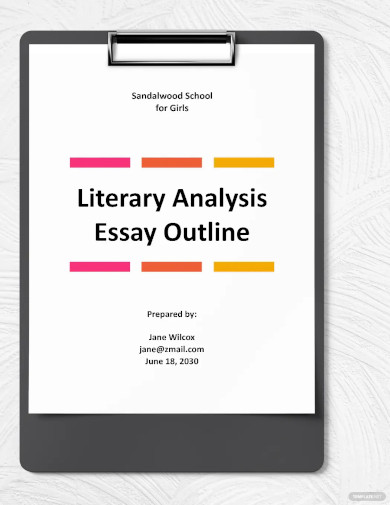
- Google Docs
2. Quotation Literary Analysis Essay Example
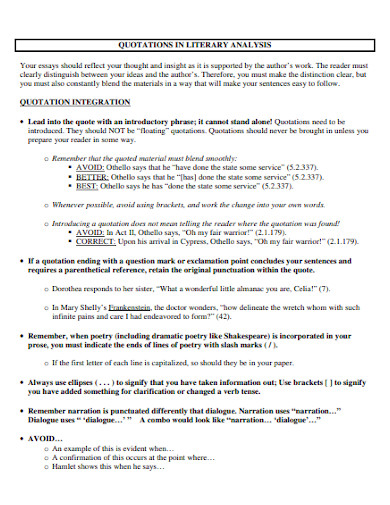
Size: 33 KB
3. Printable Literary Analysis Essay Example

Size: 252 KB
4. Building a Literary Analysis Essay Example

Size: 195 KB
5. Literary Analysis Essay Score Sheet Example
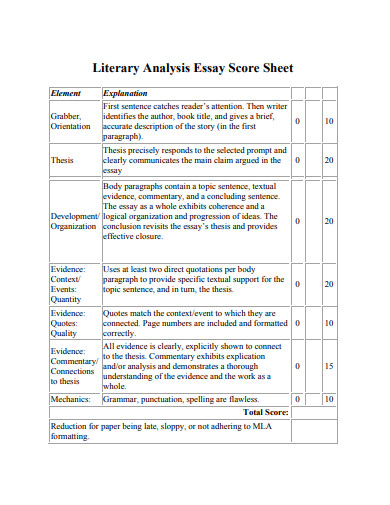
Size: 81 KB
6. Sample Literary Analysis Essay Example
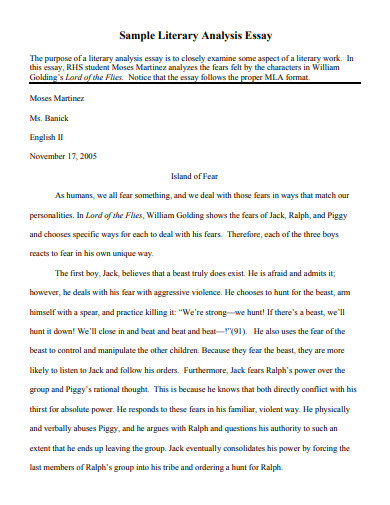
Size: 63 KB
7. Literary Analysis Essay Checklist Example
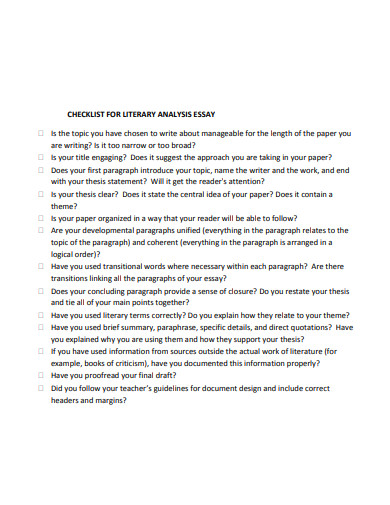
Size: 180 KB
8. Literary Analysis Essay Outline Example

Size: 51 KB
9. Editable Literary Analysis Essay Example
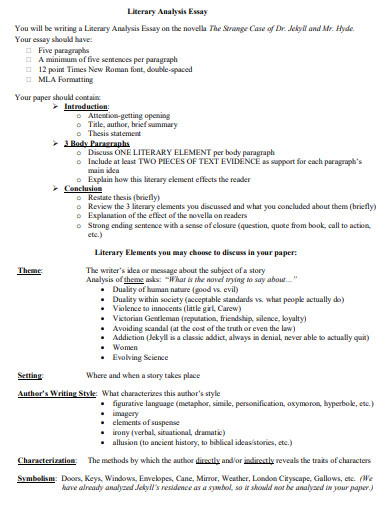
Size: 336 KB
10. Peer Editing Literary Analysis Essay Example
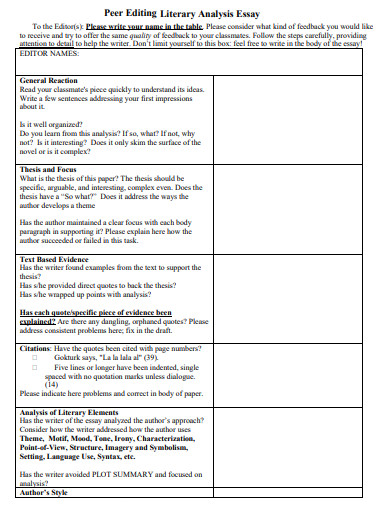
Size: 226 KB
11. Professional Literary Analysis Essay Example

Size: 41 KB
12. Literary Analysis Assessment Outline Essay Example
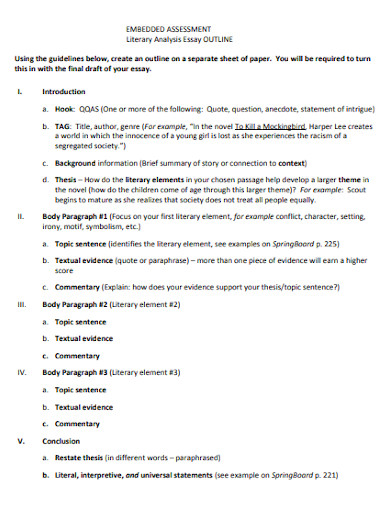
Size: 61 KB
13. High School Literary Analysis Essay Example
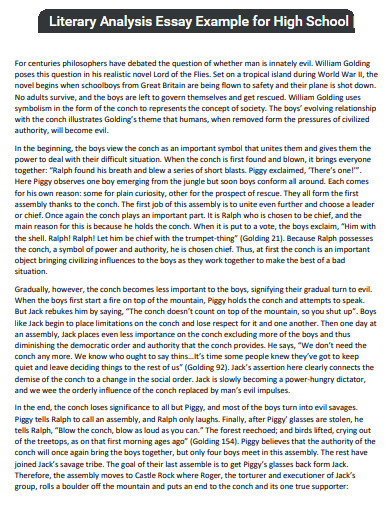
Size: 95 KB
14. Evaluation of a Literary Analysis Essay Example
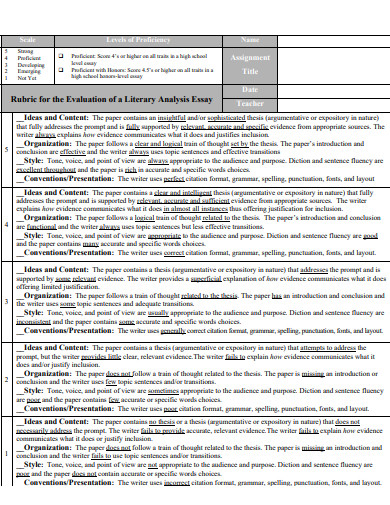
Size: 22 KB
15. Graphic Organizer Literary Analysis Essay Example

Size: 306 KB
16. Literary Analysis Essay Structure Example
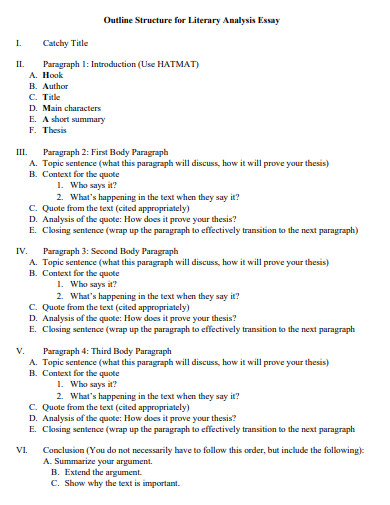
Size: 178 KB
17. Literary Analysis Essay Writing Example

18. College Literary Analysis Essay Example
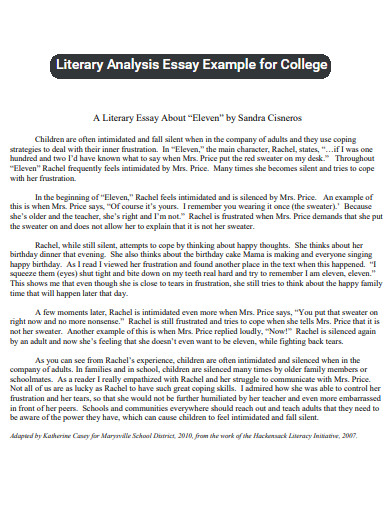
Size: 468 KB
19. Literary Analysis Essay Rubic Example

Size: 644 KB
20. Simple Literary Analysis Essay Example
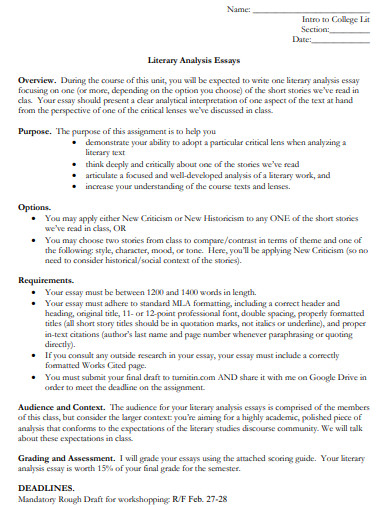
Size: 88 KB
21. Writing a Literary Analysis Essay Example
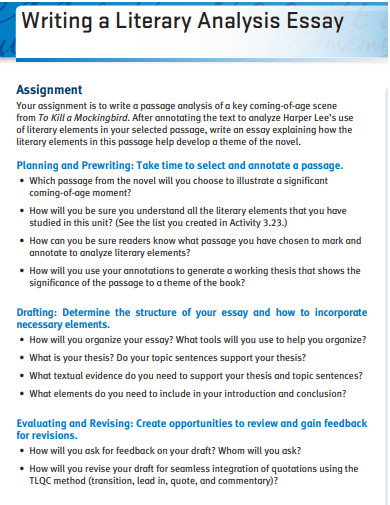
Size: 500 KB
22. Introduction to Literary Analysis Essay Example
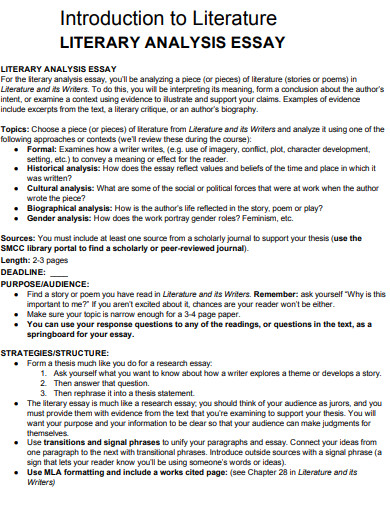
Size: 368 KB
23. Short Story Literary Analysis Essay Example

Size: 103 KB
24. 8th Grade Literary Analysis Essay Example
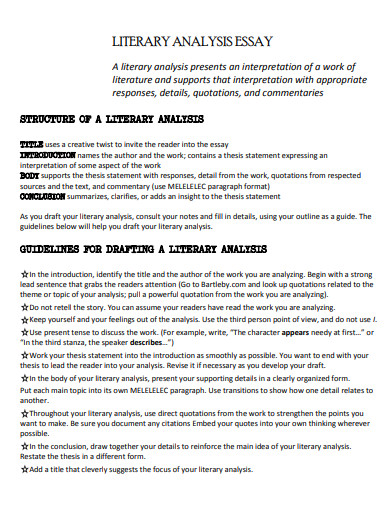
Size: 278 KB
25. Literary Analysis Essay Assignment Example
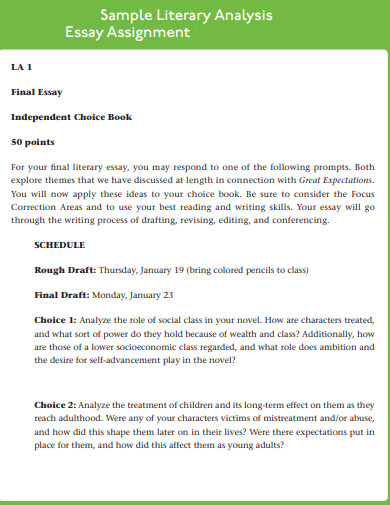
Size: 47 KB
26. Literary Analysis Video Essay Example
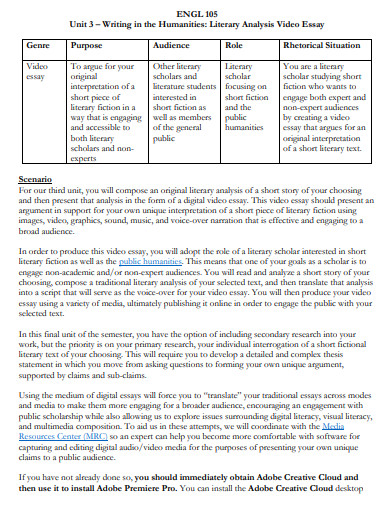
Size: 208 KB
27. Student Guide for Literary Analysis Essay Example
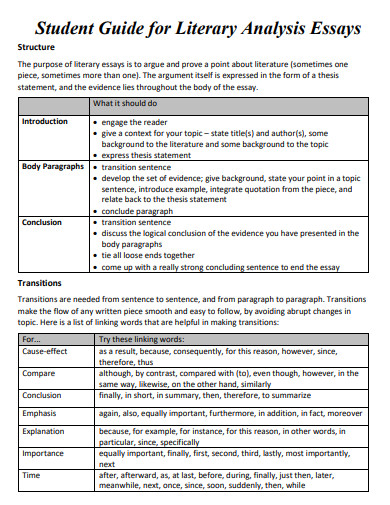
Size: 956 KB
28. MLA Literary Analysis Essay Example
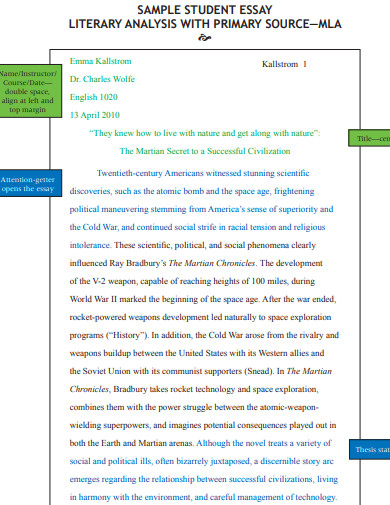
Size: 116 KB
29. Draft Literary Analysis Essay Example

Size: 112 KB
30. 9th Grade Literary Analysis Essay Example

Size: 93 KB
31. Literary Analysis Essay Guide Example
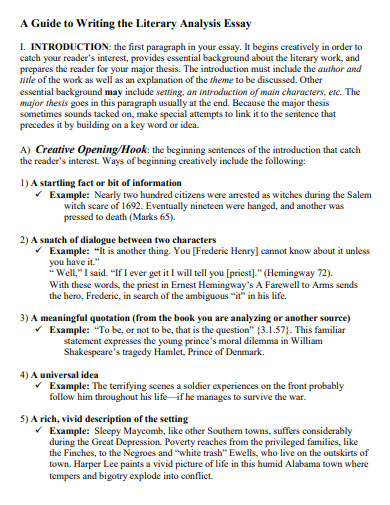
Size: 36 KB
What is a Literary Analysis Essay?
A literary analysis essay is a critical examination and interpretation of a literary work. It involves analyzing various elements such as plot, characters, themes, and literary devices to uncover deeper meanings and insights. By dissecting the text and exploring its nuances, readers can gain a deeper appreciation for the author’s intentions and the work’s impact. A well-written literary analysis essay provides a comprehensive analysis that goes beyond surface-level observations.
How to Write a Literary Analysis Essay
Before we dive into the examples, let’s outline the steps involved in writing a literary analysis essay:
Step 1: Choose a literary work:
Select a literary work that you want to analyze. It could be a novel, short story, poem, or play. Ensure that the chosen work is rich in literary elements and offers ample material for analysis.
Step 2: Familiarize yourself with the work:
Read the literary work carefully, taking note of important plot points, characters, themes, and literary devices. Pay attention to the author’s writing style and the overall tone of the work.
Step 3: Develop a thesis statement:
Craft a strong thesis statement that encapsulates your main argument or interpretation of the literary work. Your thesis should be clear, concise, and debatable, providing a roadmap for your analysis.
Step 4: Gather evidence:
Collect evidence from the literary work to support your thesis statement. Look for specific examples, quotes, and literary devices that reinforce your analysis. Take note of the context in which these elements appear.
Step 5: Organize your essay:
Create an analysis paper outline to structure your essay effectively. Divide your essay into introduction, body paragraphs, and conclusion . Each body paragraph should focus on a specific aspect of your analysis, supported by evidence.
Step 6: Write your essay:
Start with an engaging introduction that provides background information and introduces your thesis statement. In the body paragraphs, analyze different aspects of the literary work, providing evidence and explanations. Ensure a smooth flow between paragraphs. Conclude your essay by summarizing your main points and reinforcing your thesis .
What are some examples of literary devices?
Literary devices are techniques used by authors to enhance their writing and convey meaning. Examples include metaphors, similes, personification, alliteration, and symbolism. For a comprehensive list and explanations, refer to Literary Devices .
Are there any specific examples of short story analysis essays?
You can find examples of short story analysis essays in PDF format here . These examples provide insights into analyzing the elements of a short story effectively.
How does context impact literary analysis?
Context plays a crucial role in literary analysis as it helps readers understand the historical, social, and cultural background in which the literary work was written. It provides insights into the author’s intentions and influences the interpretation of the text.
Text prompt
- Instructive
- Professional
Analyze the theme of courage in a novel for your Literary Analysis Essay.
Write about the use of symbolism in a short story for your Literary Analysis Essay.
Aug 25, 2023
Literary Analysis Essay Examples: Discover How to Analyze Literature and Improve Your Writing Skills
Discover the allure of literature with our literary analysis essay examples. Uncover the hidden meanings, symbolisms, and develop your writing skills. Let's dive into these examples and master the art of literary analysis together!
Literary analysis essays offer a critical examination of a literary work, exploring how various elements contribute to an overarching theme. While crafting an impactful essay can be challenging, especially when identifying unique themes or accumulating adequate knowledge, it's entirely achievable with fundamental essay writing principles and a solid plan. This form of essay is prevalent in high school and college and plays an integral role in literary criticism. In this guide, we'll equip you with practical tips and a sample to steer your writing process. Let's delve deeper.
What is Literary Analysis?
A literary analysis is an essay that focuses on either a single element or multiple elements within a piece of writing to determine how they contribute to the main theme or purpose. This process involves a meticulous examination of the work's structure to explain or interpret the integration of its components. Writing a literary analysis may sound intimidating, but it's entirely attainable even for beginners. It involves the careful evaluation of a written piece to unearth its deeper meanings and understand the author's choices. It's not simply a summary or book review; rather, it shares similarities with an argumentative essay, providing a detailed examination of the work's language, perspective, and structure.
Furthermore, it includes an exploration of how the author employs literary devices to generate specific effects and convey ideas. Gaining inspiration for a literary analysis essay may involve understanding the work's historical context, themes, and symbolism. With these guidelines, anyone - beginners and seasoned writers alike - can create a thoughtful literary analysis essay that offers insightful interpretations of a literary work.
Writing a Literary Essay: A Step-by-Step Guide
Learning from other literary analysis essays can facilitate the writing process. This method helps understand different approaches and ways to analyze a subject. Furthermore, exploring the work of scholars and critics on your chosen literature can provide fresh perspectives and novel ideas for your essay. Here's a simplified guide of eight crucial steps to help you compose a thoughtful and well-crafted literary analysis essay.
Carefully Read the Text: Familiarize yourself with the literature you'll analyze. Understand its message by reading it multiple times, especially for shorter pieces like poetry.
Brainstorm a Topic: After comprehensively studying the work, generate a unique topic for your essay. A few probing questions can stimulate creative ideas.
Collect and Interpret Evidence: Analyze the available evidence supporting your proposed topic. Highlight key sections as you read, including contradicting evidence that could support your argument.
Write a Thesis: This is the central argument guiding your essay. Choose a debatable topic, rather than stating something universally acknowledged.
Develop and Organize Your Arguments: Organize your evidence and create a robust thesis statement . Modify your argument as needed to match the evidence.
Write a Rough Draft: Focus on delivering a thorough argument supported by textual evidence. Don't worry about perfect grammar or complex sentences at this stage.
Refine Your Arguments and Review: Be ruthless while editing. Pay attention to grammar, sentence structure, and ensure your essay aligns with your thesis.
Get Another Opinion and Finalize: Seek feedback on your essay. Analyze your writing carefully and ensure it aligns with your thesis.
In summary, following these steps will not only make your literary essay writing process more structured, but will also enhance your analytical thinking and writing skills . Keep practicing, and each essay will be a step towards mastery in literary analysis.
How to write an outline of a Literary Essay
Embarking on the journey of writing a literary analysis essay requires a roadmap to ensure a logical and coherent argument. One effective way to organize your thoughts and ideas is by creating an outline. This outline not only structures your essay, but it also guides your analysis, helping to illuminate the path from your introduction to your conclusion.
Think of your outline as a skeleton: the backbone of your essay, providing structure and support. It allows you to arrange your points systematically, ensuring you don't overlook essential elements and maintain a logical flow throughout your analysis. The following sections are the key components of this framework, each having a specific role and purpose in your essay:
Introduction: This initial section draws your readers into the world of your analysis. Providing the author's name and the work's title lays the groundwork. A thematic statement then broadens this base, offering a glimpse into the wider theme of your analysis. As your introduction unfolds, provide some contextual information about the work to highlight its relevance. Nearing the end of this section, present your readers with your thesis statement—an unambiguous declaration that encapsulates the purpose of your analysis.
Body: The body serves as the battlefield of your essay, where you tackle the issues stated in your thesis. Your primary goal is to demonstrate how the author utilized the techniques discussed in your thesis. Use persuasive evidence such as quotes and literary devices to fortify your arguments. Always keep your thesis as the central pillar of your discussion, wrapping up each paragraph with a robust statement that fortifies your argument.
Conclusion: Here, you reaffirm your thesis and show how the ideas discussed in the body support its claims. Your conclusion recaps your main points, reinforcing their significance and leaving a lasting impression on your readers regarding the depth and relevance of your analysis.
3 Literary Analysis Essay Examples
This segment presents three instances of literary analysis essays on acclaimed pieces of literature. Studying these examples will offer you insights into the various methods and strategies employed by proficient writers for literary evaluation, focusing on the elucidation of thematic undertones, symbolism interpretation, and character motivation exploration.
God Help the Child by Toni Morrison: An Analysis of Childhood Trauma
Introduction:
Toni Morrison's novel 'God Help the Child' is a powerful exploration of childhood trauma and its implications. It probes the intricate layers of the trauma experience by centralizing the narrative around an African American character, Bride.
Morrison unravels the theme of childhood trauma via Bride's life experiences. The early abandonment by her mother due to her dark skin color manifests in Bride's adulthood, influencing her relationships and self-worth. Morrison uses vivid symbolism and imagery to convey the depth of Bride's trauma, such as her white attire representing her longing for purity and acceptance. Bride's interpersonal relationships, strained by her past trauma, are realistically portrayed, aiding readers in empathizing with her experiences.
Conclusion:
In 'God Help the Child', Morrison seamlessly explores the impact of childhood trauma on individuals and society. The novel's potent imagery and symbolism simplify the complexities of trauma, making it an essential read for those interested in this theme.
The Color Purple by Alice Walker: An Examination of Gender and Identity
Alice Walker's 'The Color Purple' delves into the intricate web of gender, race, and identity during the early 20th century American South.
The novel uniquely presents the theme of gender by depicting the struggles of African American women against oppression. It also discusses the theme of identity through the protagonist Celie's life journey. Walker's symbolism, such as the color purple signifying strength and resilience, contributes to the novel's potent portrayal of gender and identity. Walker's epistolary format and colloquial language use immerse the reader in the experiences of African American women of that era.
'The Color Purple' provides a compelling narrative about gender and identity struggles. Walker's distinct use of symbolism, imagery, and language gives the novel a multifaceted perspective on these themes, securing its place in African American literature.
The Fall of the House of Usher by Edgar Allan Poe: A Study of the Supernatural
Edgar Allan Poe's short story 'The Fall of the House of Usher' examines the supernatural's influence on the human psyche.
The story is replete with supernatural elements contributing to its eerie Gothic atmosphere. These elements, such as the haunted mansion and its inhabitants' bizarre behaviors, elicit fear and unease in the reader. Poe masterfully uses these supernatural components to underline fear and terror's psychological effects. The haunted mansion symbolizes the Usher family's decay and societal decline, while the blood-red moon during the mansion's final collapse underlines the events' supernatural nature.
'The Fall of the House of Usher' successfully explores supernatural themes and their psychological implications. Poe's atmospheric storytelling and symbolism use underscore the themes of death and decay, solidifying the story's place in the Gothic tradition.
Final Thoughts
Conclusively, to craft a compelling literary analysis essay, you should select a captivating topic, meticulously evaluate the text, and present a well-organized argument. The inclusion of textual evidence and considering the broader context are equally vital. Proficient writing skills are indispensable for formulating an influential essay that manifests a profound comprehension of the text and engages the readers.
If you face challenges in crafting a literary analysis essay, consider using tools like Jenni.ai . This AI-powered platform aids in essay creation across various topics, enhancing efficiency and easing the process. It's particularly helpful when you need a persuasive essay but lack confidence in your writing skills. Give it a shot and experience a streamlined essay-writing process.
Try Jenni for free today
Create your first piece of content with Jenni today and never look back
How to Write a Film Analysis Essay: Examples, Outline, & Tips
A film analysis essay might be the most exciting assignment you have ever had! After all, who doesn’t love watching movies? You have your favorite movies, maybe something you watched years ago, perhaps a classic, or a documentary. Or your professor might assign a film for you to make a critical review. Regardless, you are totally up for watching a movie for a film analysis essay.
Our specialists will write a custom essay specially for you!
However, once you have watched the movie, facing the act of writing might knock the wind out of your sails because you might be wondering how to write a film analysis essay. In summary, writing movie analysis is not as difficult as it might seem, and Custom-writing.org experts will prove this. This guide will help you choose a topic for your movie analysis, make an outline, and write the text.️ Film analysis examples are added as a bonus! Just keep reading our advice on how to get started.
❓ What Is a Film Analysis Essay?
- 🚦 Film Analysis Types
📽️ Movie Analysis Format
✍️ how to write a film analysis, 🎦 film analysis template, 🎬 film analysis essay topics.
- 📄 Essay Examples
🔗 References
To put it simply, film analysis implies watching a movie and then considering its characteristics : genre, structure, contextual context, etc. Film analysis is usually considered to be a form of rhetorical analysis . The key to success here is to formulate a clear and logical argument, supporting it with examples.
🚦 Film Analysis Essay Types
Since a film analysis essay resembles literature analysis, it makes sense that there are several ways to do it. Its types are not limited to the ones described here. Moreover, you are free to combine the approaches in your essay as well. Since your writing reflects your own opinion, there is no universal way to do it.

- Semiotic analysis . If you’re using this approach, you are expected to interpret the film’s symbolism. You should look for any signs that may have a hidden meaning. Often, they reveal some character’s features. To make the task more manageable, you can try to find the objects or concepts that appear on the screen multiple times. What is the context they appear in? It might lead you to the hidden meaning of the symbols.
- Narrative structure analysis . This type is quite similar to a typical literature guide. It includes looking into the film’s themes, plot, and motives. The analysis aims to identify three main elements: setup, confrontation, and resolution. You should find out whether the film follows this structure and what effect it creates. It will make the narrative structure analysis essay if you write about the theme and characters’ motivations as well.
- Contextual analysis . Here, you would need to expand your perspective. Instead of focusing on inner elements, the contextual analysis looks at the time and place of the film’s creation. Therefore, you should work on studying the cultural context a lot. It can also be a good idea to mention the main socio-political issues of the time. You can even relate the film’s success to the director or producer and their career.
- Mise-en-scene analysis . This type of analysis works with the most distinctive feature of the movies, audiovisual elements. However, don’t forget that your task is not only to identify them but also to explain their importance. There are so many interconnected pieces of this puzzle: the light to create the mood, the props to show off characters’ personalities, messages hidden in the song lyrics.
To write an effective film analysis essay, it is important to follow specific format requirements that include the following:
- Standard essay structure. Just as with any essay, your analysis should consist of an introduction with a strong thesis statement, body paragraphs, and a conclusion. The main body usually includes a summary and an analysis of the movie’s elements.
- Present tense for events in the film. Use the present tense when describing everything that happens in the movie. This way, you can make smooth transitions between describing action and dialogue. It will also improve the overall narrative flow.
- Proper formatting of the film’s title. Don’t enclose the movie’s title in quotation marks; instead, italicize it. In addition, use the title case : that is, capitalize all major words.
- Proper use of the characters’ names. When you mention a film character for the first time, name the actor portraying them. After that, it is enough to write only the character’s name.
- In-text citations. Use in-text citations when describing certain scenes or shots from the movie. Format them according to your chosen citation style. If you use direct quotes, include the time-stamp range instead of page numbers. Here’s how it looks in the MLA format: (Smith 0:11:24–0:12:35).
Even though film analysis is similar to the literary one, you might still feel confused with where to begin. No need to worry; there are only a few additional steps you need to consider during the writing process.
Just in 1 hour! We will write you a plagiarism-free paper in hardly more than 1 hour
Need more information? It can be found in the video below.
Starting Your Film Analysis Essay
There are several things you need to do before you start writing your film analysis paper. First and foremost, you have to watch the movie. Even if you have seen it a hundred times, you need to watch it again to make a good film analysis essay.
Note that you might be given an essay topic or have to think of it by yourself. If you are free to choose a topic for your film analysis essay, reading some critical reviews before you watch the film might be a good idea. By doing this in advance, you will already know what to look for when watching the movie.
In the process of watching, keep the following tips in mind:
- Consider your impression of the movie
- Enumerate memorable details
- Try to interpret the movie message in your way
- Search for the proof of your ideas (quotes from the film)
- Make comments on the plot, settings, and characters
- Draw parallels between the movie you are reviewing and some other movies
Making a Film Analysis Essay Outline
Once you have watched and possibly re-watched your assigned or chosen movie from an analytical point of view, you will need to create a movie analysis essay outline . The task is pretty straightforward: the outline can look just as if you were working on a literary analysis or an article analysis.
Receive a plagiarism-free paper tailored to your instructions. Cut 15% off your first order!
- Introduction : This includes the basics of the movie, including the title, director, and the date of release. You should also present the central theme or ideas in the movie and your thesis statement .
- Summary : This is where you take the time to present an overview of the primary concepts in the movie, including the five Ws (who, what, when, where, and why)—don’t forget how!—as well as anything you wish to discuss that relates to the point of view, style, and structure.
- Analysis : This is the body of the essay and includes your critical analysis of the movie, why you did or did not like it, and any supporting material from the film to support your views. It would help if you also discussed whether the director and writer of the movie achieved the goal they set out to achieve.
- Conclusion: This is where you can state your thesis again and provide a summary of the primary concepts in a new and more convincing manner, making a case for your analysis. You can also include a call-to-action that will invite the reader to watch the movie or avoid it entirely.
You can find a great critical analysis template at Thompson Rivers University website. In case you need more guidance on how to write an analytical paper, check out our article .
Writing & Editing Your Film Analysis Essay
We have already mentioned that there are differences between literary analysis and film analysis. They become especially important when one starts writing their film analysis essay.
First of all, the evidence you include to support the arguments is not the same. Instead of quoting the text, you might need to describe the audiovisual elements.
However, the practice of describing the events is similar in both types. You should always introduce a particular sequence in the present tense. If you want to use a piece of a dialogue between more than two film characters, you can use block quotes. However, since there are different ways to do it, confirm with your supervisor.
For your convenience, you might as well use the format of the script, for which you don’t have to use quotation marks:
Get an originally-written paper according to your instructions!
ELSA: But she won’t remember I have powers?
KING: It’s for the best.
Finally, to show off your proficiency in the subject, look at the big picture. Instead of just presenting the main elements in your analysis, point out their significance. Describe the effect they make on the overall impression form the film. Moreover, you can dig deeper and suggest the reasons why such elements were used in a particular scene to show your expertise.
Stuck writing a film analysis essay? Worry not! Use our template to structure your movie analysis properly.
Introduction
- The title of the film is… [title]
- The director is… [director’s name] He/she is known for… [movies, style, etc.]
- The movie was released on… [release date]
- The themes of the movie are… [state the film’s central ideas]
- The film was made because… [state the reasons]
- The movie is… because… [your thesis statement].
- The main characters are… [characters’ names]
- The events take place in… [location]
- The movie is set in… [time period]
- The movie is about… [state what happens in the film and why]
- The movie left a… [bad, unforgettable, lasting, etc.] impression in me.
- The script has… [a logical sequence of events, interesting scenes, strong dialogues, character development, etc.]
- The actors portray their characters… [convincingly, with intensity, with varying degree of success, in a manner that feels unnatural, etc.]
- The soundtrack is [distracting, fitting, memorable, etc.]
- Visual elements such as… [costumes, special effects, etc.] make the film [impressive, more authentic, atmospheric, etc.]
- The film succeeds/doesn’t succeed in engaging the target audience because it… [tells a compelling story, features strong performances, is relevant, lacks focus, is unauthentic, etc.]
- Cultural and societal aspects make the film… [thought-provoking, relevant, insightful, problematic, polarizing, etc.]
- The director and writer achieved their goal because… [state the reasons]
- Overall, the film is… [state your opinion]
- I would/wouldn’t recommend watching the movie because… [state the reasons]
- Analysis of the film Inception by Christopher Nolan .
- Examine the rhetoric in the film The Red Balloon .
- Analyze the visual effects of Zhang Yimou’s movie Hero .
- Basic concepts of the film Interstellar by Christopher Nolan.
- The characteristic features of Federico Fellini’s movies.
- Analysis of the movie The Joker .
- The depiction of ethical issues in Damaged Care .
- Analyze the plot of the film Moneyball .
- Explore the persuasive techniques used in Henry V .
- Analyze the movie Killing Kennedy .
- Discuss the themes of the film Secret Window .
- Describe the role of audio and video effects in conveying the message of the documentary Life in Renaissance .
- Compare and analyze the films Midnight Cowboy and McCabe and Mrs. Miller .
- Analysis of the movie Rear Window .
- The message behind the film Split .
- Analyze the techniques used by Tim Burton in his movie Sleepy Hollow .
- The topic of children’s abuse and importance of trust in Joseph Sargent’s Sybil .
- Examine the themes and motives of the film Return to Paradise by Joseph Ruben .
- The issues of gender and traditions in the drama The Whale Rider.
- Analysis of the film Not Easily Broken by Duke Bill.
- The symbolism in R. Scott’s movie Thelma and Louise .
- The meaning of audiovisual effects in Citizen Kane .
- Analyze the main characters of The Girl with the Dragon Tattoo .
- Discuss the historical accuracy of the documentary The Civil War .
- Analysis of the movie Through a Glass Darkly .
- Explore the core idea of the comedy Get Out .
- The problem of artificial intelligence and human nature in Ex Machina .
- Three principles of suspense used in the drama The Fugitive .
- Examine the ideas Michael Bay promotes in Armageddon .
- Analyze the visual techniques used in Tenet by Christopher Nolan.
- Analysis of the movie The Green Mile .
- Discrimination and exclusion in the film The Higher Learning .
- The hidden meaning of the scenes in Blade Runner .
- Compare the social messages of the films West Side Story and Romeo + Juliet .
- Highlighting the problem of children’s mental health in the documentary Kids in Crisis .
- Discuss the ways Paul Haggis establishes the issue of racial biases in his movie Crash .
- Analyze the problem of moral choice in the film Gone Baby Gone .
- Analysis of the historical film Hacksaw Ridge .
- Explore the main themes of the film Mean Girls by Mark Walters .
- The importance of communication in the movie Juno .
- Describe the techniques the authors use to highlight the problems of society in Queen and Slim .
- Examine the significance of visual scenes in My Family/ Mi Familia .
- Analysis of the thriller Salt by Phillip Noyce.
- Analyze the message of Greg Berlanti’s film Love, Simon .
- Interpret the symbols of the film The Wizard of Oz (1939).
- Discuss the modern issues depicted in the film The Corporation .
- Moral lessons of Edward Zwick’s Blood Diamond .
- Analysis of the documentary Solitary Nation .
- Describe the audiovisual elements of the film Pride and Prejudice (2005) .
- The problem of toxic relationships in Malcolm and Marie .
📄 Film Analysis Examples
Below you’ll find two film analysis essay examples. Note that the full versions are downloadable for free!
Film Analysis Example #1: The Intouchables
Raising acute social problems in modern cinema is a common approach to draw the public’s attention to the specific issues and challenges of people facing crucial obstacles. As a film for review, The Intouchables by Oliver Nakache and Éric Toledano will be analyzed, and one of the themes raised in this movie is the daily struggle of the person with severe disabilities. This movie is a biographical drama with comedy elements. The Intouchables describes the routine life of a French millionaire who is confined to a wheelchair and forced to receive help from his servants. The acquaintance of the disabled person with a young and daring man from Parisian slums changes the lives of both radically. The film shows that for a person with disabilities, recognition as a full member of society is more important than sympathy and compassion, and this message expressed comically raises an essential problem of human loneliness.
Movie Analysis Example #2: Parasite
Parasite is a 2019 South Korean black comedy thriller movie directed by Bong Joon-ho and is the first film with a non-English script to win Best Picture at the Oscars in 2020. With its overwhelming plot and acting, this motion picture retains a long-lasting effect and some kind of shock. The class serves as a backbone and a primary objective of social commentary within the South Korean comedy/thriller (Kench, 2020). Every single element and detail in the movie, including the student’s stone, the contrasting architecture, family names, and characters’ behavior, contribute to the central topic of the universal problem of classism and wealth disparity. The 2020 Oscar-winning movie Parasite (2019) is a phenomenal cinematic portrayal and a critical message to modern society regarding the severe outcomes of the long-established inequalities within capitalism.
Want more examples? Check out this bonus list of 10 film analysis samples. They will help you gain even more inspiration.
- “Miss Representation” Documentary Film Analysis
- “The Patriot”: Historical Film Analysis
- “The Morning Guy” Film Analysis
- 2012′ by Roland Emmerich Film Analysis
- “The Crucible” (1996) Film Analysis
- The Aviator’ by Martin Scorsese Film Analysis
- The “Lions for Lambs” Film Analysis
- Bill Monroe – Father of Bluegrass Music Film Analysis
- Lord of the Rings’ and ‘Harry Potter’ Film Analysis
- Red Tails by George Lucas Film Analysis
Film Analysis Essay FAQ
- Watch the movie or read a detailed plot summary.
- Read others’ film reviews paying attention to details like key characters, movie scenes, background facts.
- Compose a list of ideas about what you’ve learned.
- Organize the selected ideas to create a body of the essay.
- Write an appropriate introduction and conclusion.
The benefits of analyzing a movie are numerous . You get a deeper understanding of the plot and its subtle aspects. You can also get emotional and aesthetic satisfaction. Film analysis enables one to feel like a movie connoisseur.
Here is a possible step by step scenario:
- Think about the general idea that the author probably wanted to convey.
- Consider how the idea was put across: what characters, movie scenes, and details helped in it.
- Study the broader context: the author’s other works, genre essentials, etc.
The definition might be: the process of interpreting a movie’s aspects. The movie is reviewed in terms of details creating the artistic value. A film analysis essay is a paper presenting such a review in a logically structured way.
- Film Analysis – UNC Writing Center
- Film Writing: Sample Analysis // Purdue Writing Lab
- Yale Film Analysis – Yale University
- Film Terms And Topics For Film Analysis And Writing
- Questions for Film Analysis (Washington University)
- Resources on Film Analysis – Cinema Studies (University of Toronto)
- Does Film Analysis Take the Magic out of Movies?
- Film Analysis Research Papers – Academia.edu
- What’s In a Film Analysis Essay? Medium
- Analysis of Film – SAGE Research Methods
- Share to Facebook
- Share to Twitter
- Share to LinkedIn
- Share to email

A critique paper is an academic writing genre that summarizes and gives a critical evaluation of a concept or work. Or, to put it simply, it is no more than a summary and a critical analysis of a specific issue. This type of writing aims to evaluate the impact of...

What is a creative essay, if not the way to express yourself? Crafting such a paper is a task that allows you to communicate your opinion and tell a story. However, even using your imagination to a great extent doesn’t free you from following academic writing rules. Don’t even get...

A compare and contrast essay — what is it? In this type of paper, you compare two different things or ideas, highlighting what is similar between the two, and you also contrast them, highlighting what is different. The two things might be events, people, books, points of view, lifestyles, or...

What is an expository essay? This type of writing aims to inform the reader about the subject clearly, concisely, and objectively. The keyword here is “inform”. You are not trying to persuade your reader to think a certain way or let your own opinions and emotions cloud your work. Just stick to the...
![how to write an analysis essay example Short Story Analysis: How to Write It Step by Step [New]](https://custom-writing.org/blog/wp-content/uploads/2020/12/man-sits-end-trolltunga-before-mountains-284x153.jpg)
Have you ever tried to write a story analysis but ended up being completely confused and lost? Well, the task might be challenging if you don’t know the essential rules for literary analysis creation. But don’t get frustrated! We know how to write a short story analysis, and we are...

Have you ever tried to get somebody round to your way of thinking? Then you should know how daunting the task is. Still, if your persuasion is successful, the result is emotionally rewarding. A persuasive essay is a type of writing that uses facts and logic to argument and substantiate...
![how to write an analysis essay example Common Essay Mistakes—Writing Errors to Avoid [Updated]](https://custom-writing.org/blog/wp-content/uploads/2020/12/avoid-mistakes-ccw-284x153.jpg)
One of the most critical skills that students gain during their college years is assignment writing. Composing impressive essays and research papers can be quite challenging, especially for ESL students. Nonetheless, before learning the art of academic writing, you may make numerous common essay mistakes. Such involuntary errors appear in:...

You’re probably thinking: I’m no Mahatma Gandhi or Steve Jobs—what could I possibly write in my memoir? I don’t even know how to start an autobiography, let alone write the whole thing. But don’t worry: essay writing can be easy, and this autobiography example for students is here to show...
![how to write an analysis essay example Why I Want to Be a Teacher Essay: Writing Guide [2024]](https://custom-writing.org/blog/wp-content/uploads/2020/12/senior-male-professor-writing-blackboard-with-chalk3-284x153.jpg)
Some people know which profession to choose from childhood, while others decide much later in life. However, and whenever you come to it, you may have to elaborate on it in your personal statement or cover letter. This is widely known as “Why I Want to Be a Teacher” essay.
![how to write an analysis essay example Friendship Essay: Writing Guide & Topics on Friendship [New]](https://custom-writing.org/blog/wp-content/uploads/2020/12/smiley-female-friends-fist-bumping-284x153.jpg)
Assigned with an essay about friendship? Congrats! It’s one of the best tasks you could get. Digging through your memories and finding strong arguments for this paper can be an enjoyable experience. I bet you will cope with this task effortlessly as we can help you with the assignment. Just...

When you are assigned an autobiography to write, tens, and even hundreds of questions start buzzing in your head. How to write autobiography essay parts? What to include? How to make your autobiography writing flow? Don’t worry about all this and use the following three simple principles and 15 creative...

A life experience essay combines the elements of narration, description, and self-reflection. Such a paper has to focus on a single event that had a significant impact on a person’s worldview and values. Writing an essay about life experience prompts students to do the following: You may struggle with such...
Have you ever read a review and asked yourself how the critic arrived at a different interpretation for the film? You are sure that you saw the same movie, but you interpreted it differently. Most moviegoers go to the cinema for pleasure and entertainment. There’s a reason why blockbuster movies attract moviegoers – cinema is a form of escape, a way to momentarily walk away from life’s troubles.
EXCELENT COVERAGE!

Hi Rebecca,
Glad you liked the post. Sure thing, feel free to share the link with your audience!
All the best.
Purdue Online Writing Lab Purdue OWL® College of Liberal Arts
Welcome to the Purdue Online Writing Lab

Welcome to the Purdue OWL
This page is brought to you by the OWL at Purdue University. When printing this page, you must include the entire legal notice.
Copyright ©1995-2018 by The Writing Lab & The OWL at Purdue and Purdue University. All rights reserved. This material may not be published, reproduced, broadcast, rewritten, or redistributed without permission. Use of this site constitutes acceptance of our terms and conditions of fair use.
The Online Writing Lab at Purdue University houses writing resources and instructional material, and we provide these as a free service of the Writing Lab at Purdue. Students, members of the community, and users worldwide will find information to assist with many writing projects. Teachers and trainers may use this material for in-class and out-of-class instruction.
The Purdue On-Campus Writing Lab and Purdue Online Writing Lab assist clients in their development as writers—no matter what their skill level—with on-campus consultations, online participation, and community engagement. The Purdue Writing Lab serves the Purdue, West Lafayette, campus and coordinates with local literacy initiatives. The Purdue OWL offers global support through online reference materials and services.
A Message From the Assistant Director of Content Development
The Purdue OWL® is committed to supporting students, instructors, and writers by offering a wide range of resources that are developed and revised with them in mind. To do this, the OWL team is always exploring possibilties for a better design, allowing accessibility and user experience to guide our process. As the OWL undergoes some changes, we welcome your feedback and suggestions by email at any time.
Please don't hesitate to contact us via our contact page if you have any questions or comments.
All the best,
Social Media
Facebook twitter.

IMAGES
VIDEO
COMMENTS
Table of contents. Step 1: Reading the text and identifying literary devices. Step 2: Coming up with a thesis. Step 3: Writing a title and introduction. Step 4: Writing the body of the essay. Step 5: Writing a conclusion. Other interesting articles.
Step 1: Decide on Your Stance. Before diving into writing, it's crucial to establish your stance on the topic. Let's say you're going to write an analytical essay example about the benefits and drawbacks of remote work. Before you start writing, you need to decide what your opinion or viewpoint is on this topic.
When writing an analytical essay, start by formulating a thesis statement that includes the topic and the main goal of your text. It will help you create an analytical essay outline and show your readers what you will discuss in your analysis essay. Add it to the last paragraph of your analytical essay introduction.
Body. The body of your essay is not limited to three points, as shown above, but three is typically considered the minimum for a good analysis. To make your analysis more compelling, present your points and arguments in a "strong, stronger, strongest" format. main point #1 - a strong point. strong supporting evidence #1.
The analysis paper uses evidence to support the argument, such as excerpts from the piece of writing. All analytical papers include a thesis, analysis of the topic, and evidence to support that analysis. When developing an analytical essay outline and writing your essay, follow these five steps: #1: Choose a topic. #2: Write your thesis.
An analytical essay is a type of essay that involves looking at a subject of interest and explaining what it is saying. Whatever topic you choose, your writing better dissect, dissect, dissect.
How to Write an Analytical Essay in 7 Simple Steps. Written by MasterClass. Last updated: Jun 7, 2021 • 3 min read. Analytical essays provide a way to share your insights about a work of literature, scientific study, or historical event. Analytical essays provide a way to share your insights about a work of literature, scientific study, or ...
Provide a lead-in for the reader by offering a general introduction to the topic of the paper. Include your thesis statement, which shifts the reader from the generalized introduction to the specific topic and its related issues to your unique take on the essay topic. Present a general outline of the analysis paper.
2. Create an outline for your analysis. Building on your thesis and the arguments you sketched out while doing your close read of the document, create a brief outline. Make sure to include the main arguments you would like to make as well as the evidence you will use to support each argument.
with a strong analytical question that you will try to answer in your essay. Your answer to that question will be your essay's thesis. You may have many questions as you consider a source or set of sources, but not all of your questions will form the basis of a strong essay. For example, your initial questions
Conclusion. In order to create a powerful thesis statement, follow this step-by-step guideline: Brainstorm an interesting topic. Make the topic more specific. Formulate the question for further research. Extract the main idea and make a statement. Decide on your position on the topic. Mention an opposing position.
Finding a Strong Topic for Your Essay. Choosing the right topic is a crucial first step in writing an analytical essay. The topic sets the tone for the entire essay and determines its scope and focus. It is important to select a topic that is engaging, relevant, and allows for in-depth analysis. This section will provide you with helpful ...
To write an analysis essay, you need to study your topic thoroughly and conduct a research. After that, it is a good idea to think about the structure of your essay. Decide on the position, that you are going to defend. Besides, think about the opposite arguments and the evidence for the support of your central point.
Do: briefly mention the title, author, and publication date of the text you're analyzing. 2. Write your body paragraphs. Each body paragraph should have 1) a topic sentence, 2) an analysis of some part of the text and 3) evidence from the text that supports your analysis and your thesis statement.
Step 1: Choose a literary work: Select a literary work that you want to analyze. It could be a novel, short story, poem, or play. Ensure that the chosen work is rich in literary elements and offers ample material for analysis.
The term regularly used for the development of the central idea of a literary analysis essay is the body. In this section you present the paragraphs (at least 3 paragraphs for a 500-750 word essay) that support your thesis statement. Good literary analysis essays contain an explanation of your ideas and evidence from the text (short story,
Keep practicing, and each essay will be a step towards mastery in literary analysis. How to write an outline of a Literary Essay. Embarking on the journey of writing a literary analysis essay requires a roadmap to ensure a logical and coherent argument. One effective way to organize your thoughts and ideas is by creating an outline.
Writing an analysis requires a particular structure and key components to create a compelling argument. The following steps can help you format and write your analysis: Choose your argument. Define your thesis. Write the introduction. Write the body paragraphs. Add a conclusion. 1. Choose your argument.
In addition, use the title case: that is, capitalize all major words. Proper use of the characters' names. When you mention a film character for the first time, name the actor portraying them. After that, it is enough to write only the character's name. In-text citations.
How to Write a Critical Analysis Essay. Written by MasterClass. Last updated: Jun 7, 2021 • 3 min read. Critical analysis essays can be a daunting form of academic writing, but crafting a good critical analysis paper can be straightforward if you have the right approach.
The Online Writing Lab at Purdue University houses writing resources and instructional material, and we provide these as a free service of the Writing Lab at Purdue. Students, members of the community, and users worldwide will find information to assist with many writing projects. Teachers and trainers may use this material for in-class and out ...
An example from the personal statements above: Example essay 4 begins with a story about being at a protest and watching the lights of the local prison flicker in response to the crowd's chanting. The middle of the essay talks about a challenge faced, a lesson the writer learned, and then why a particular law school is suited for the writer ...